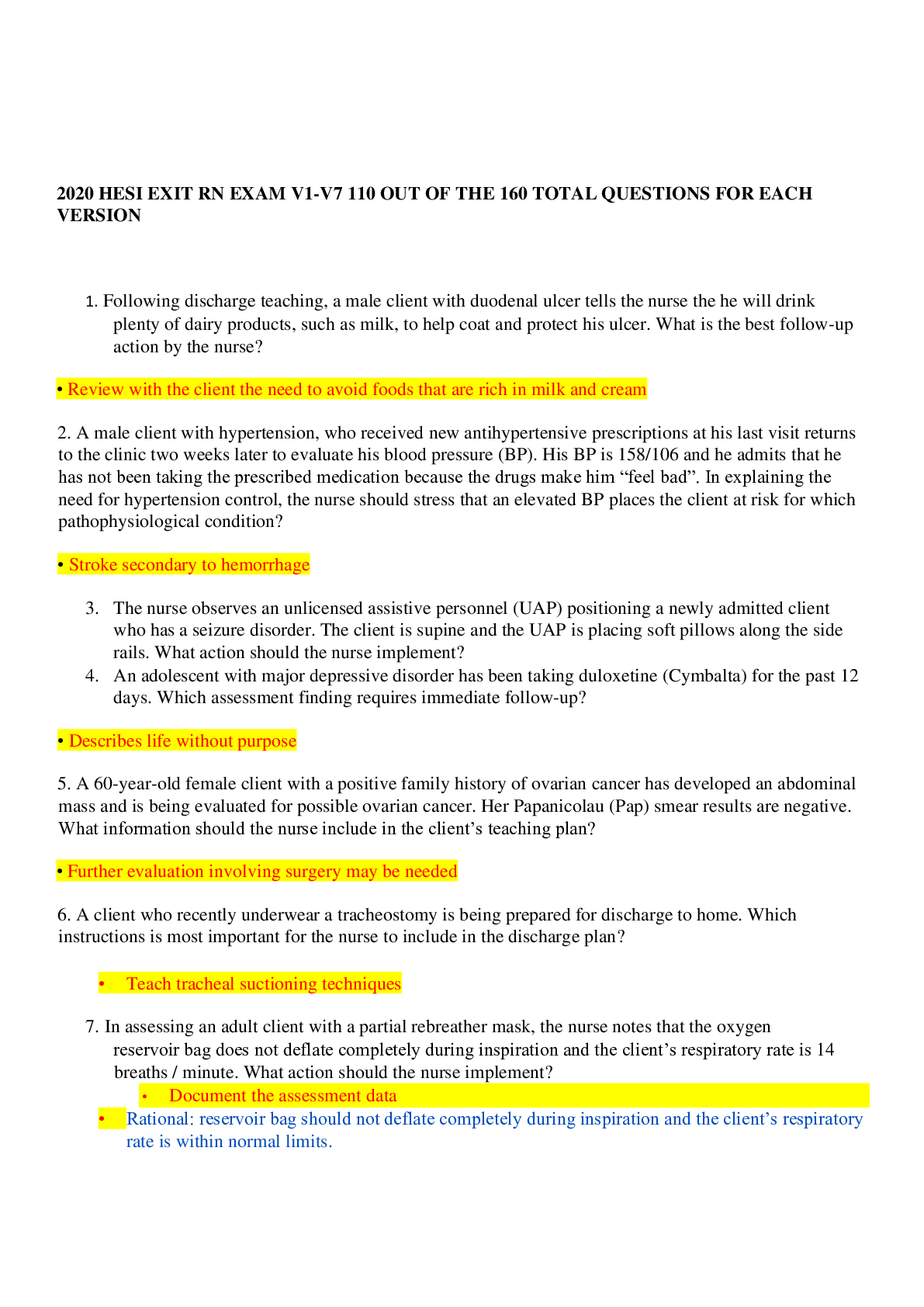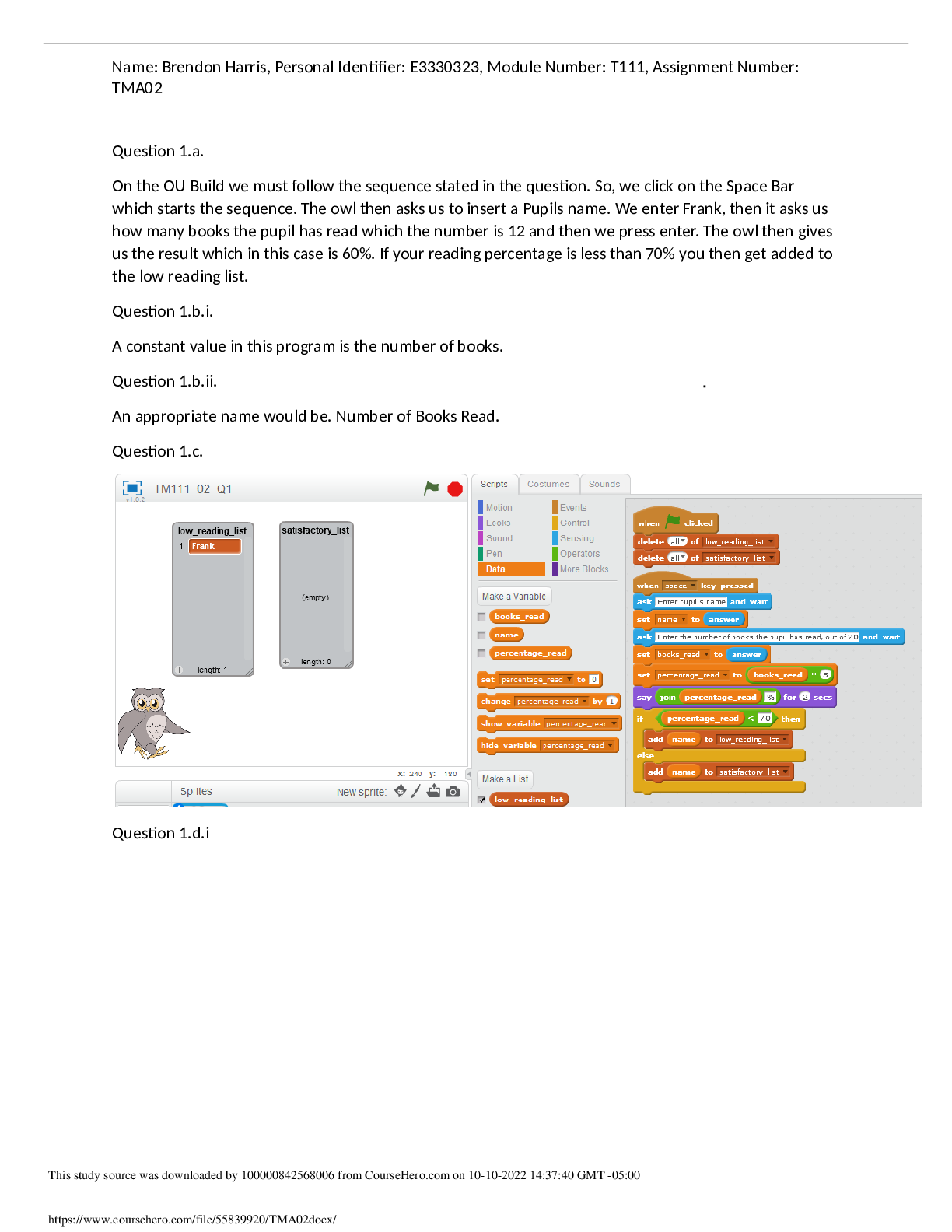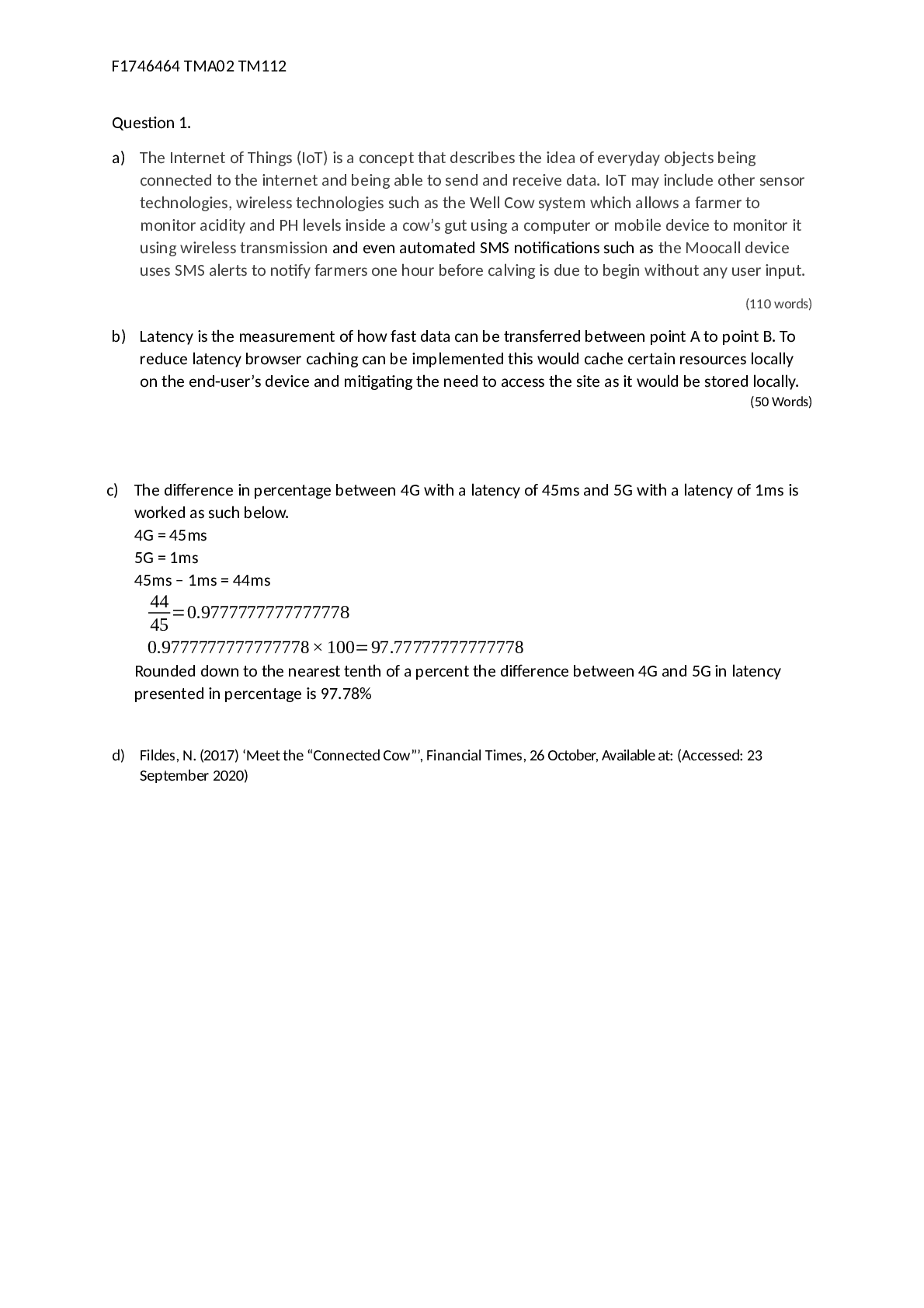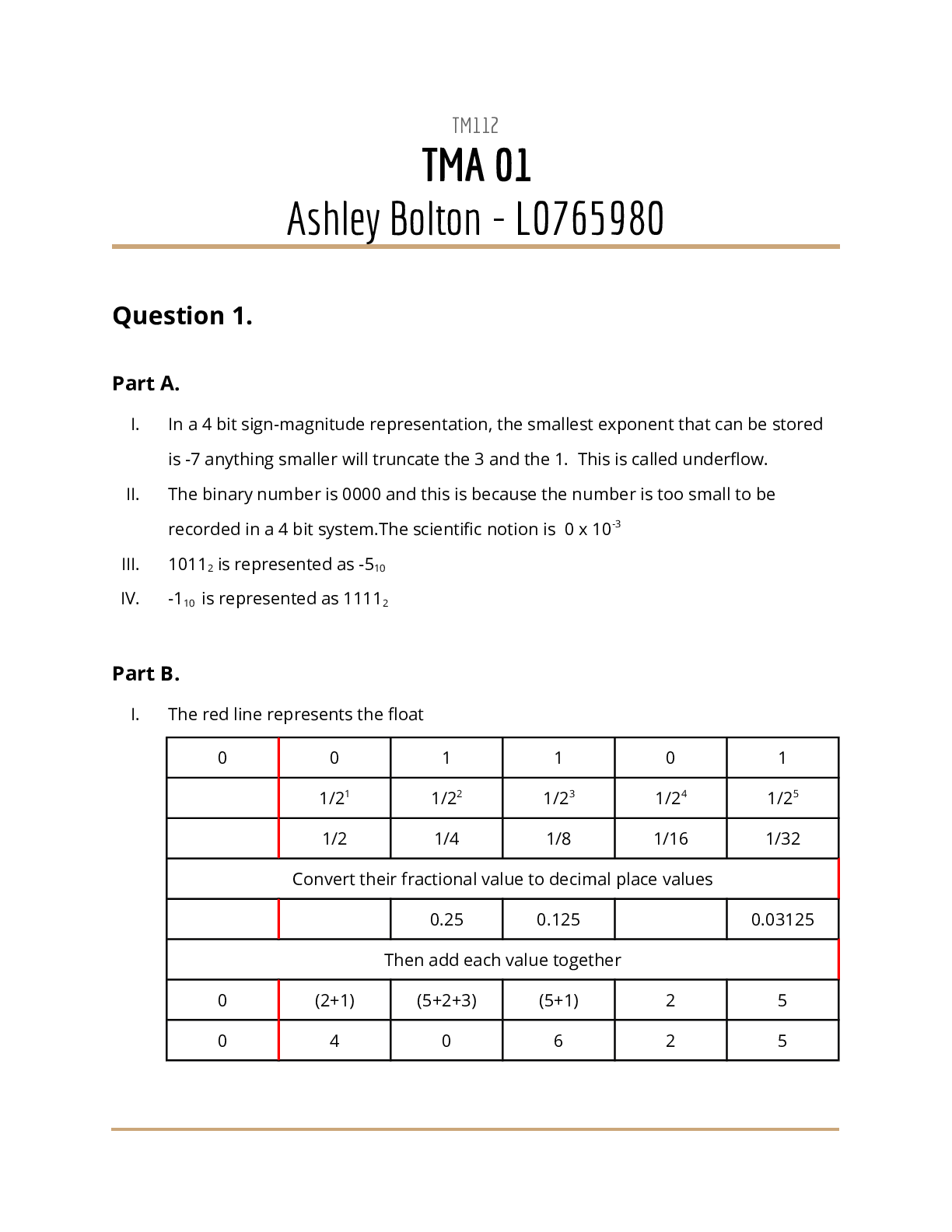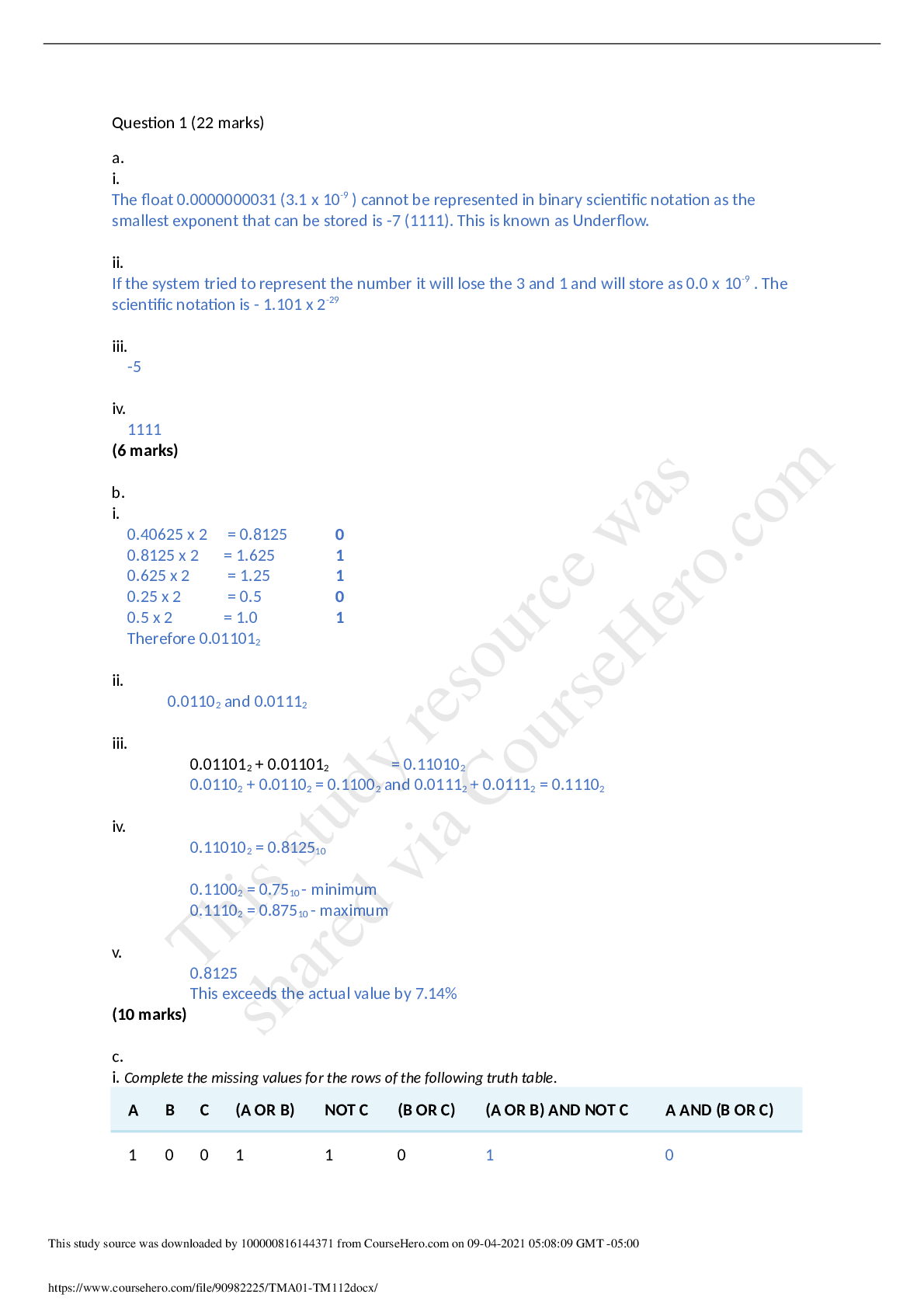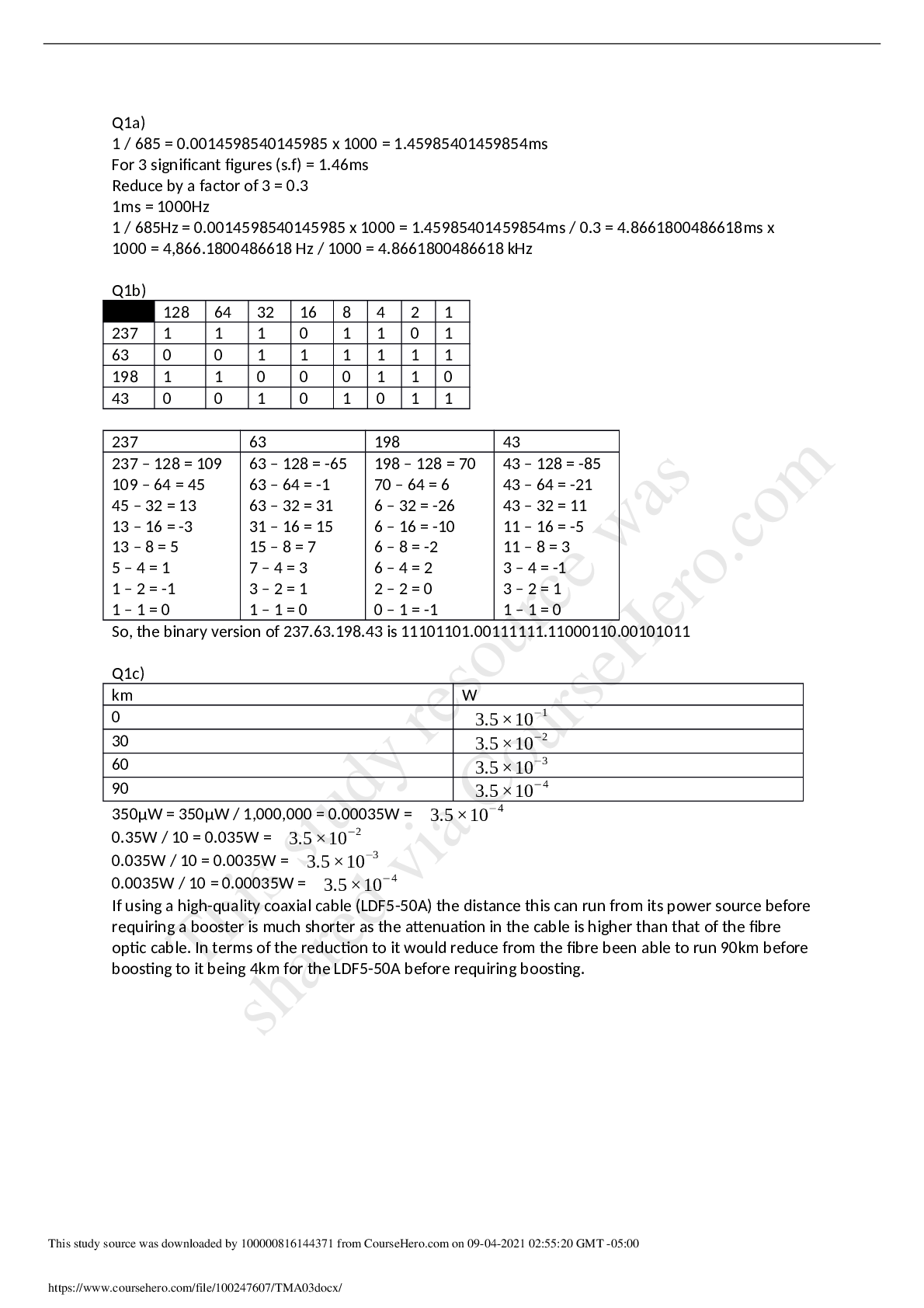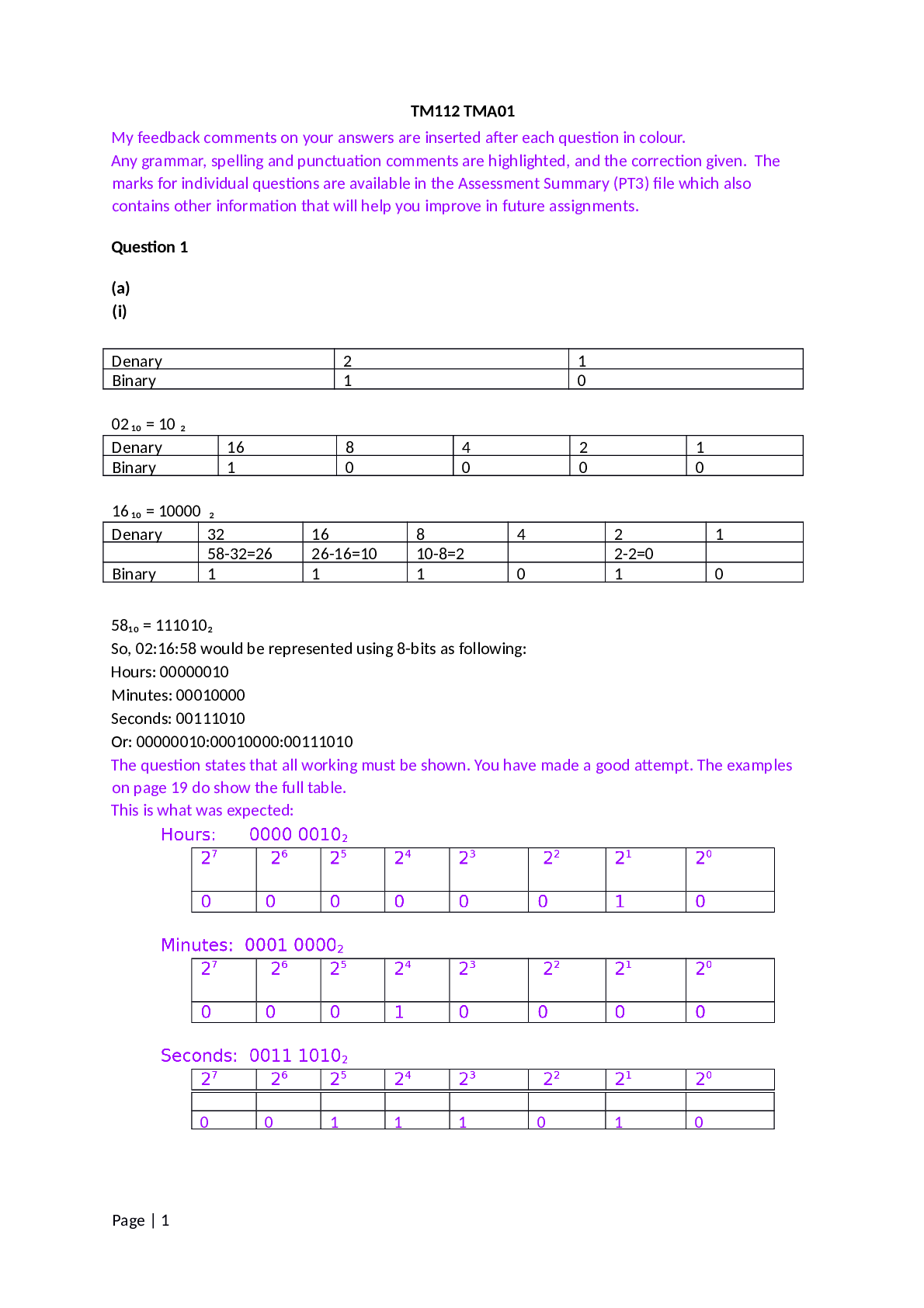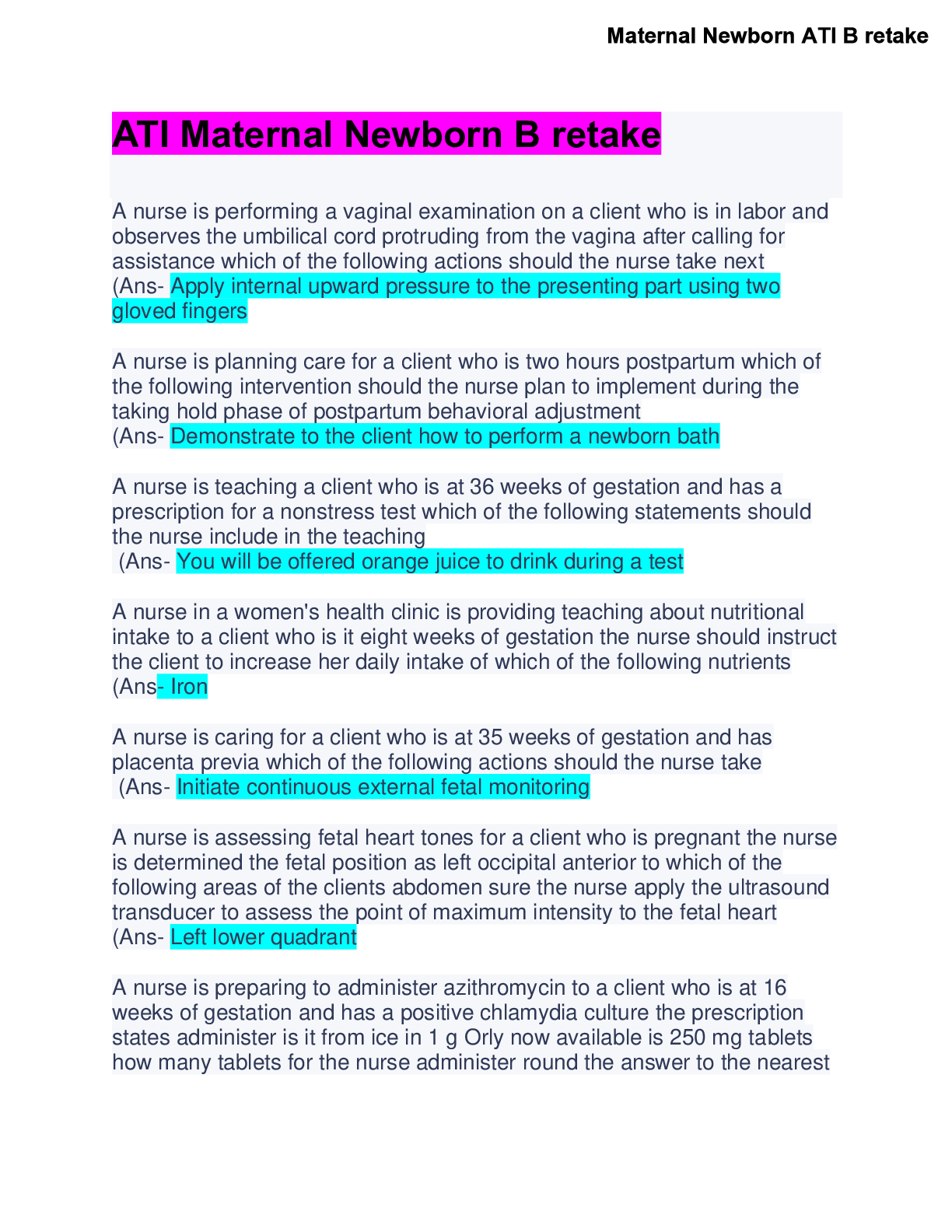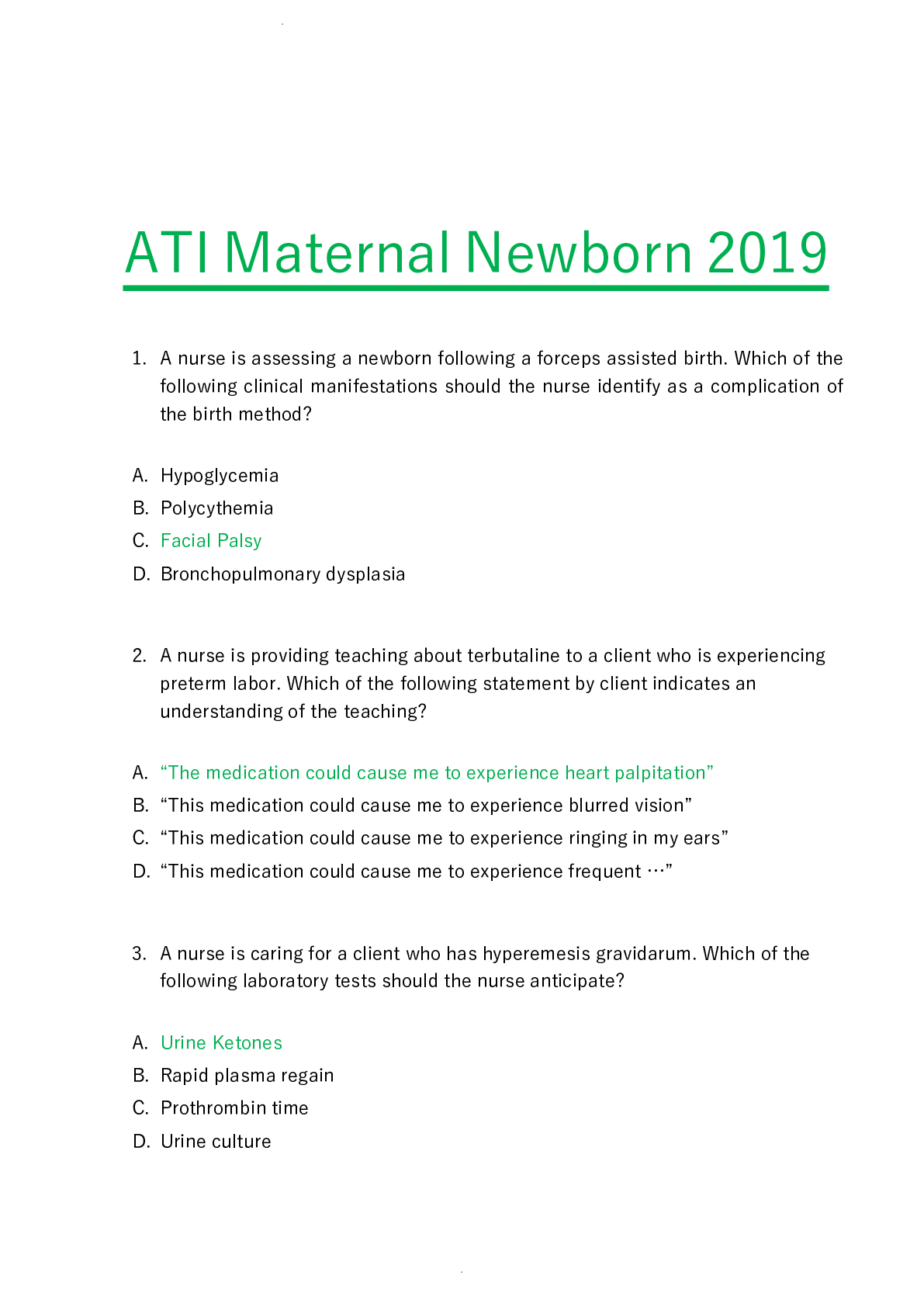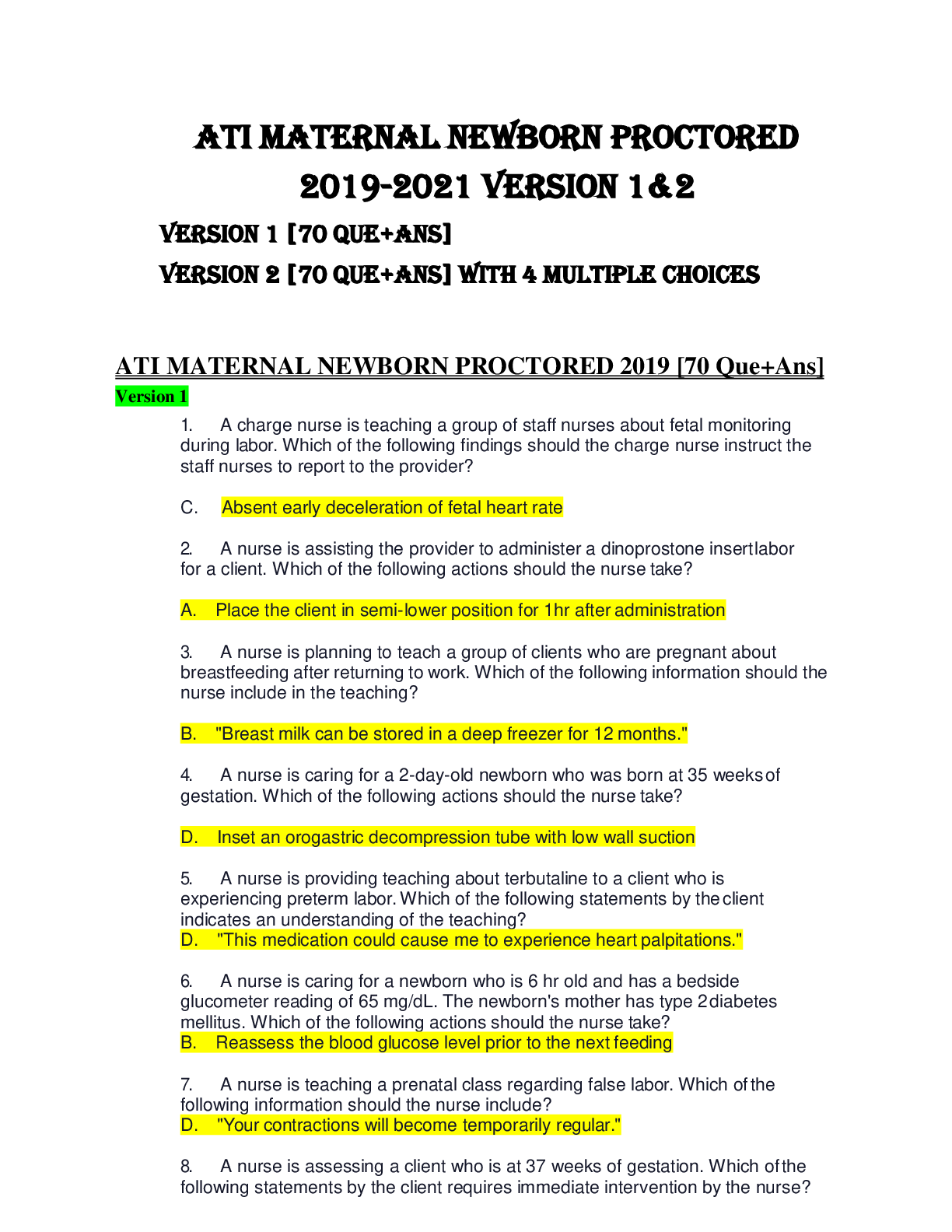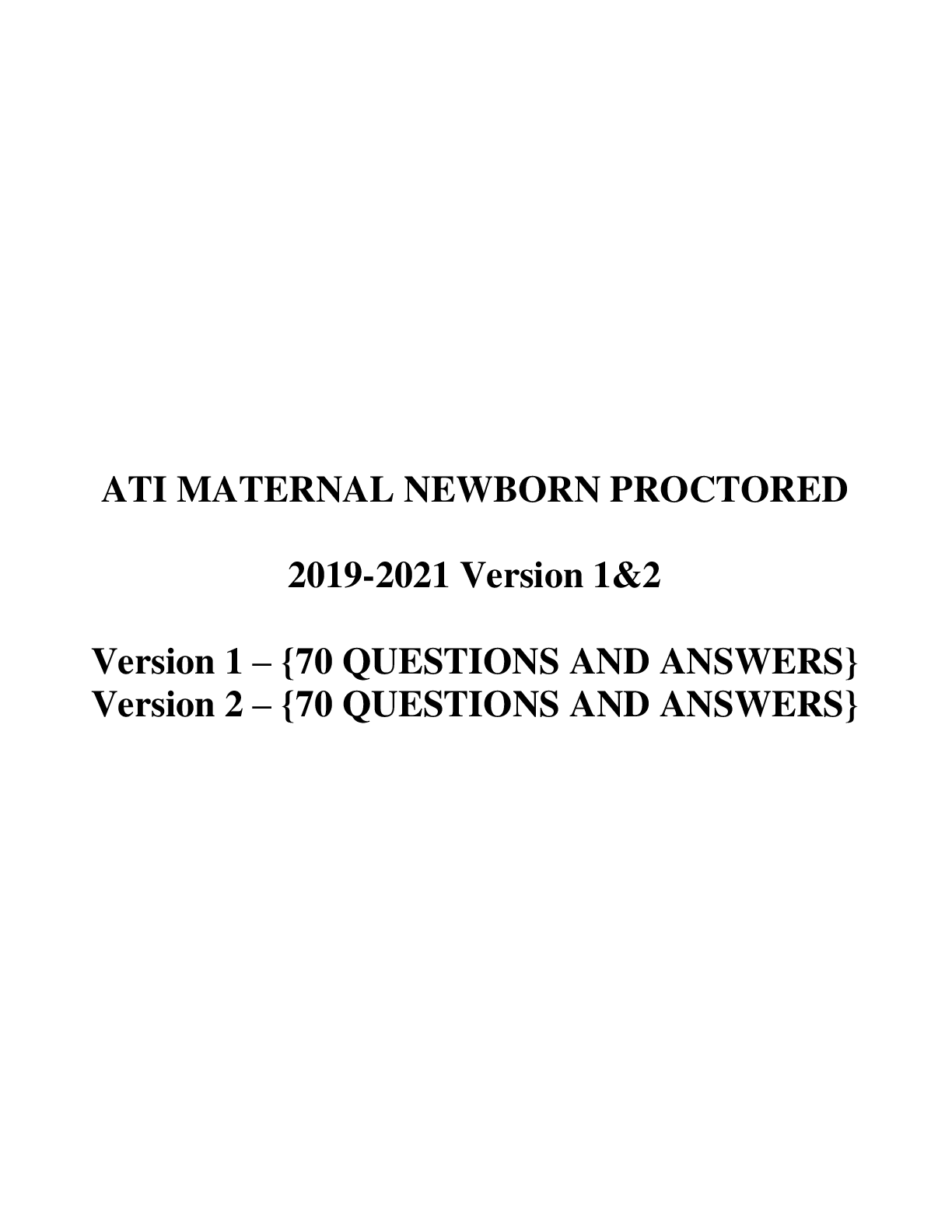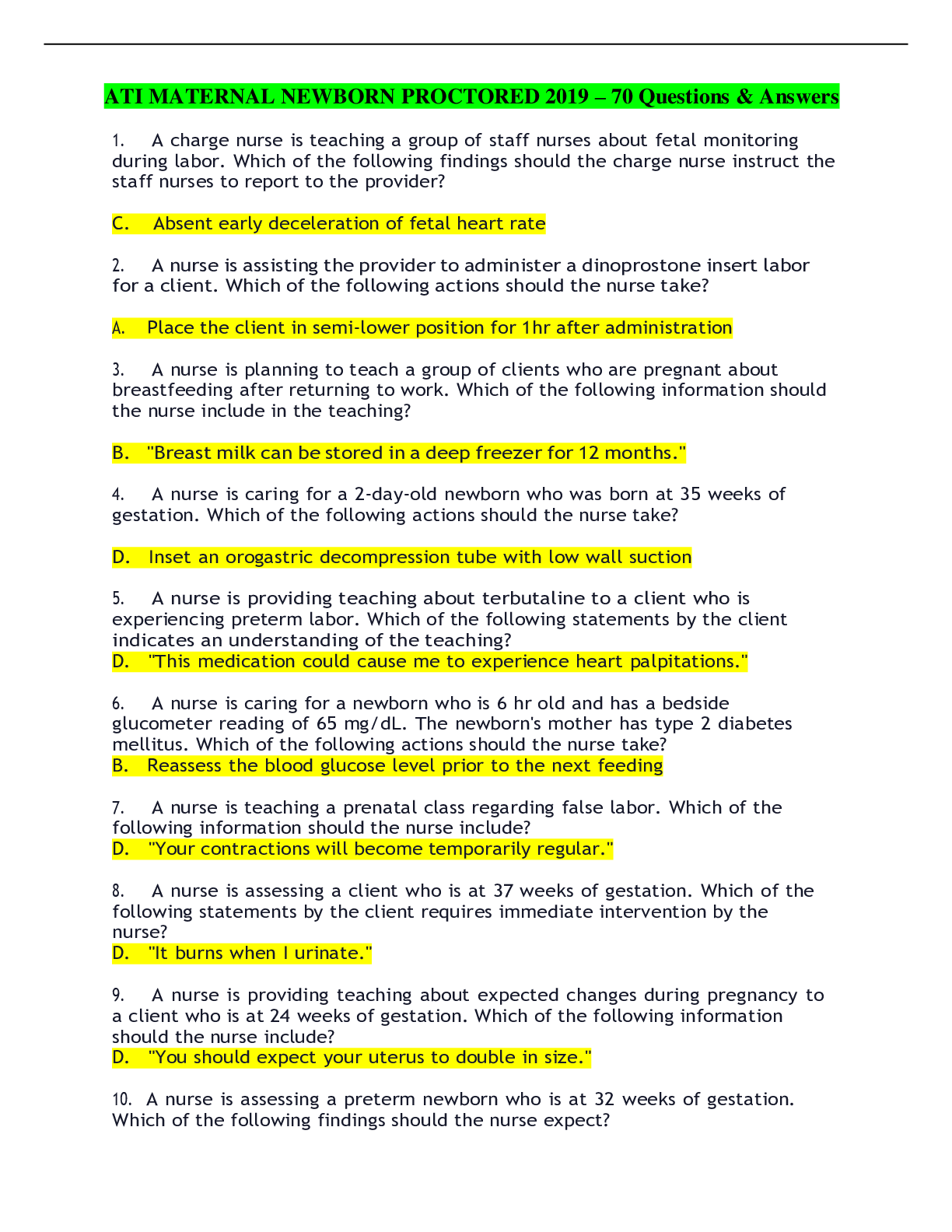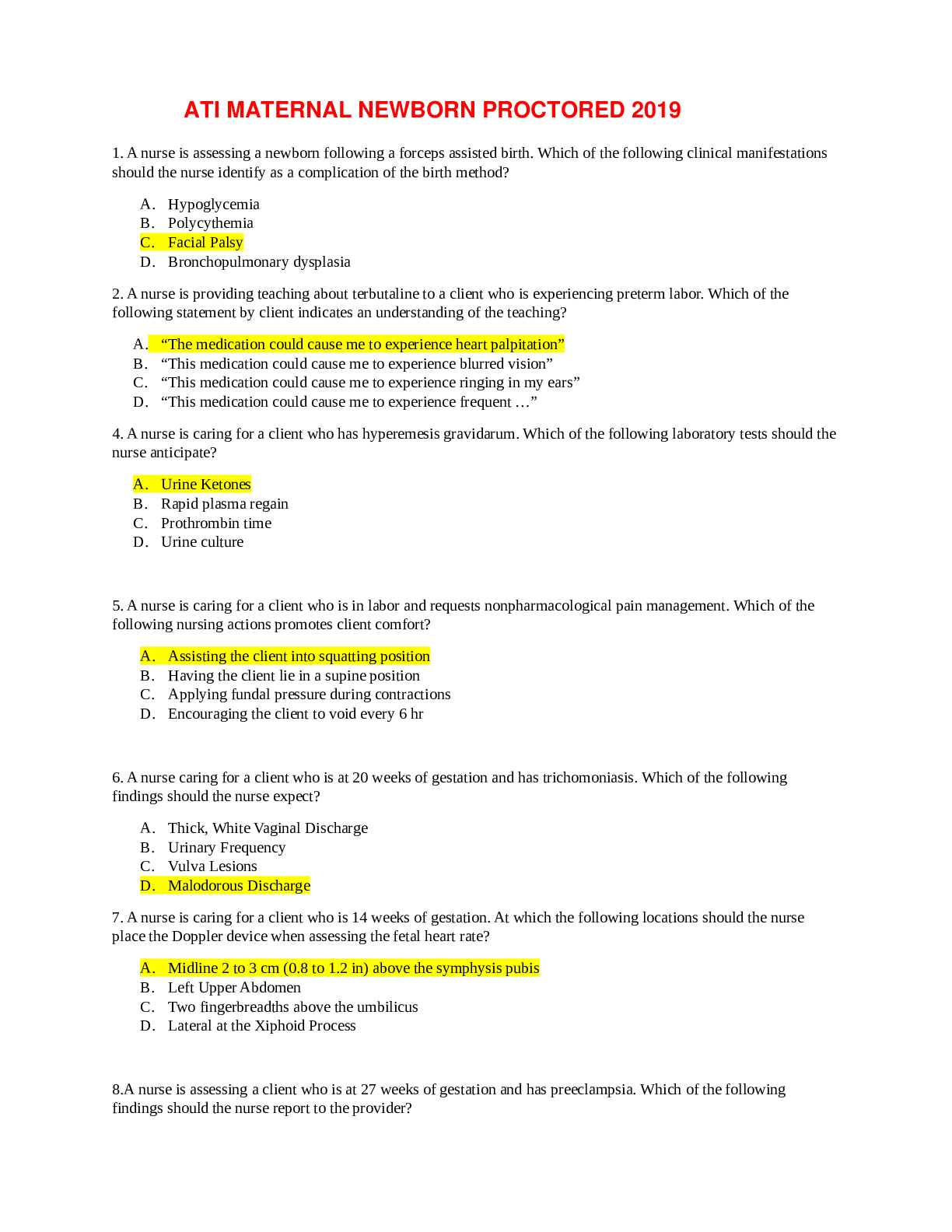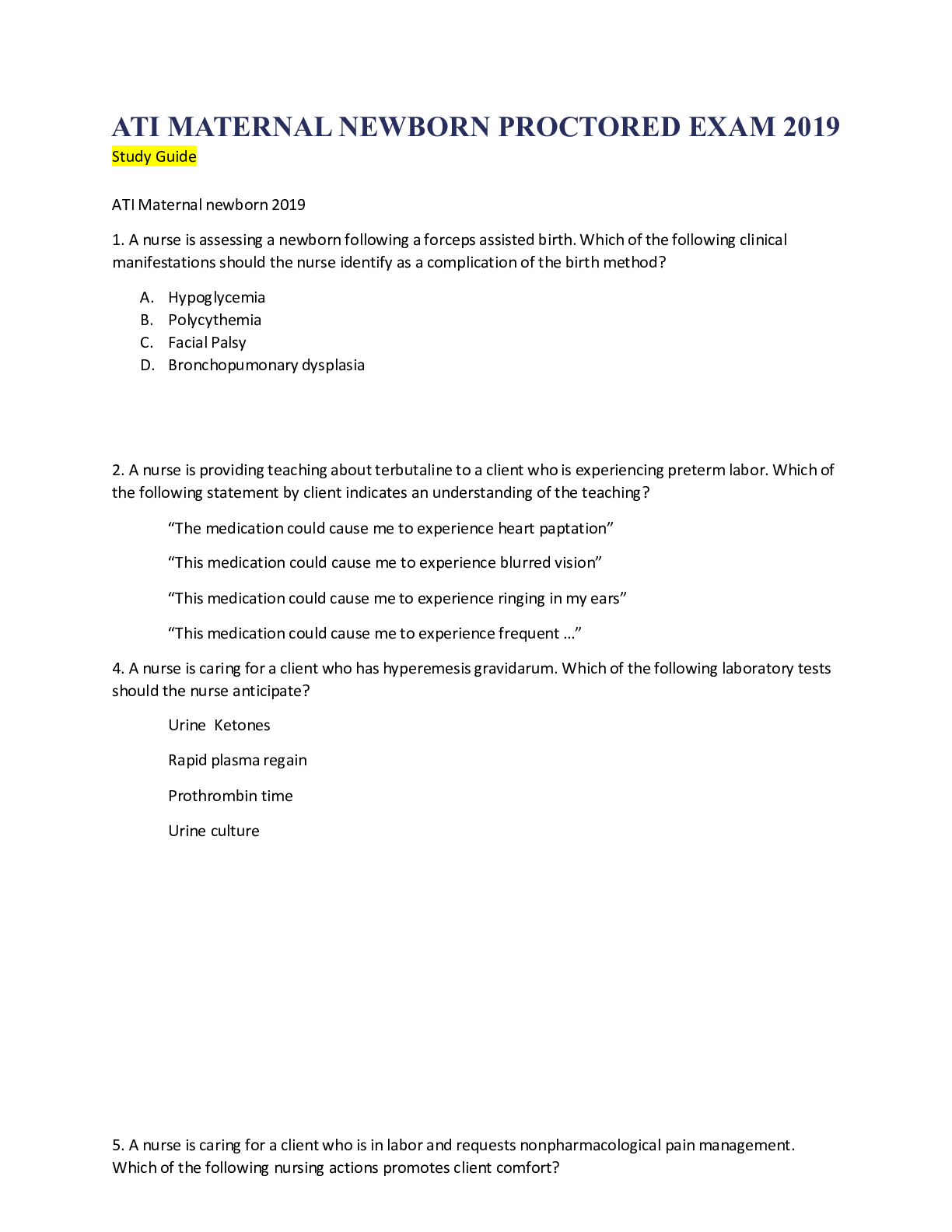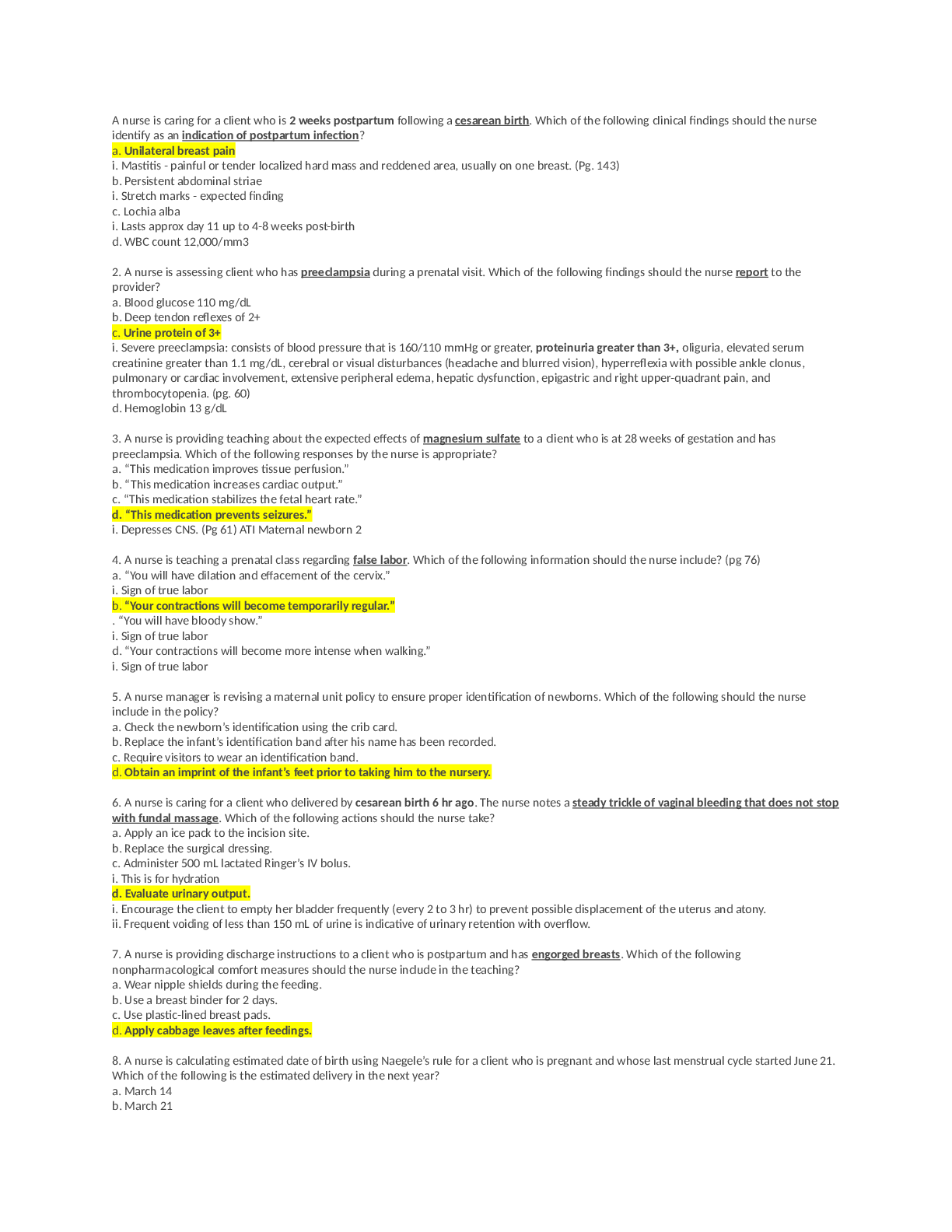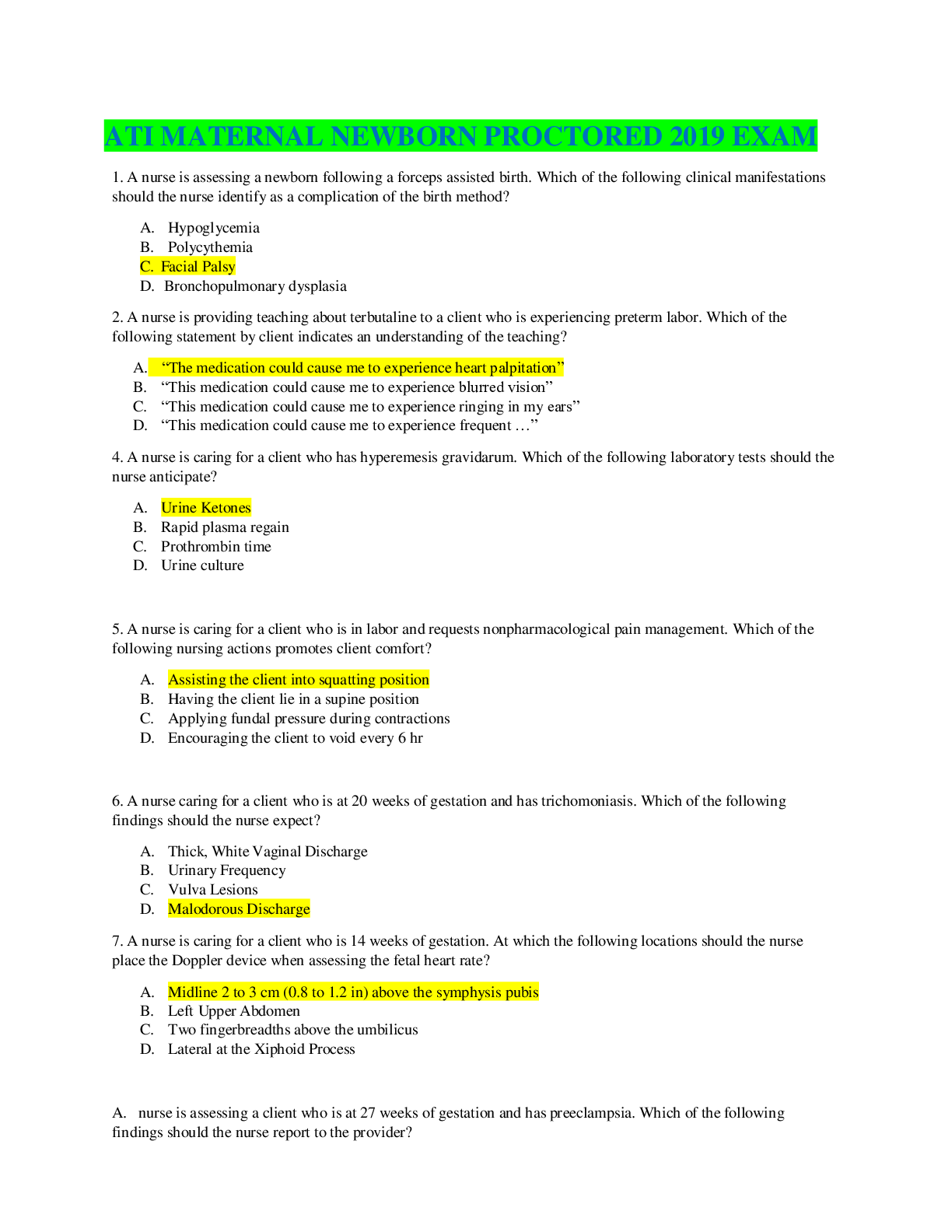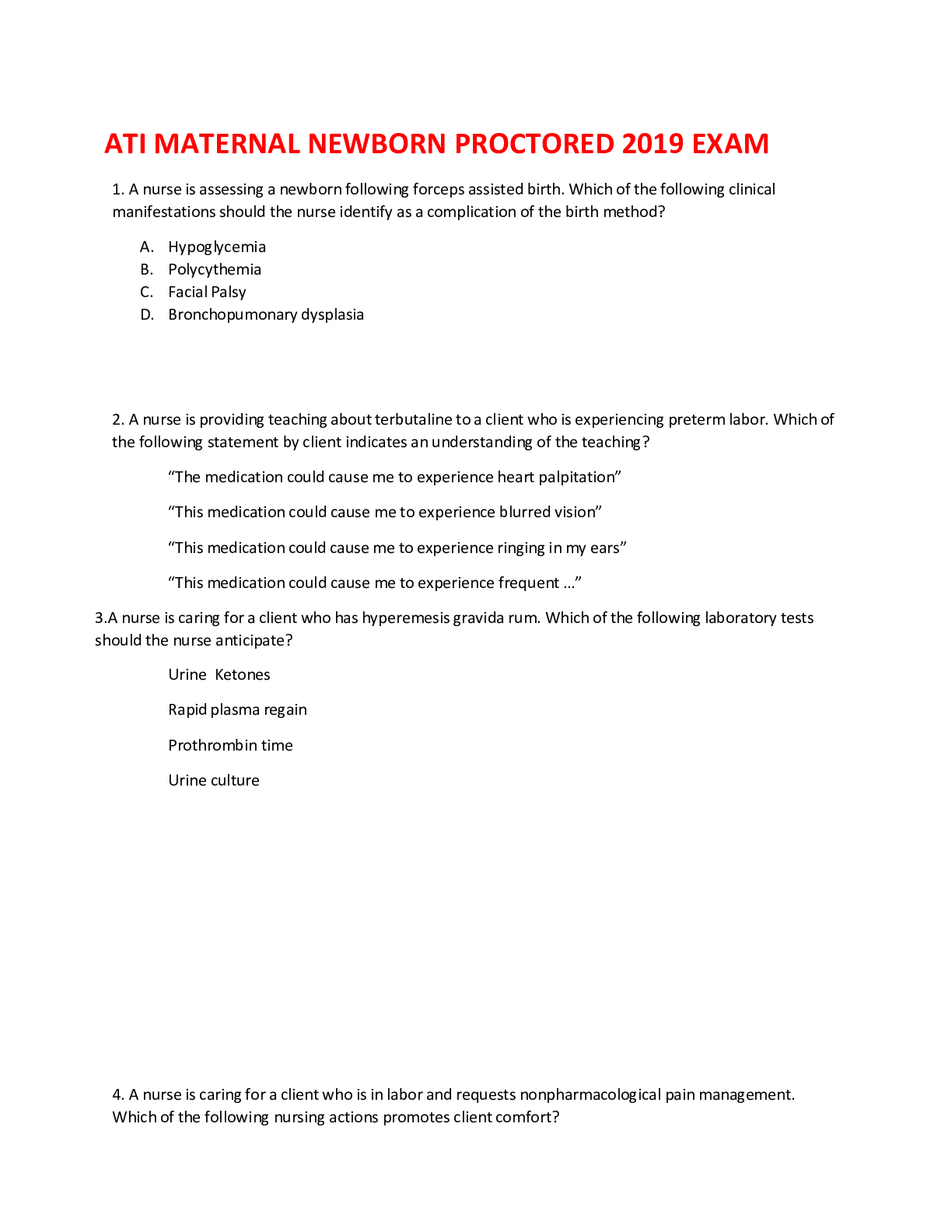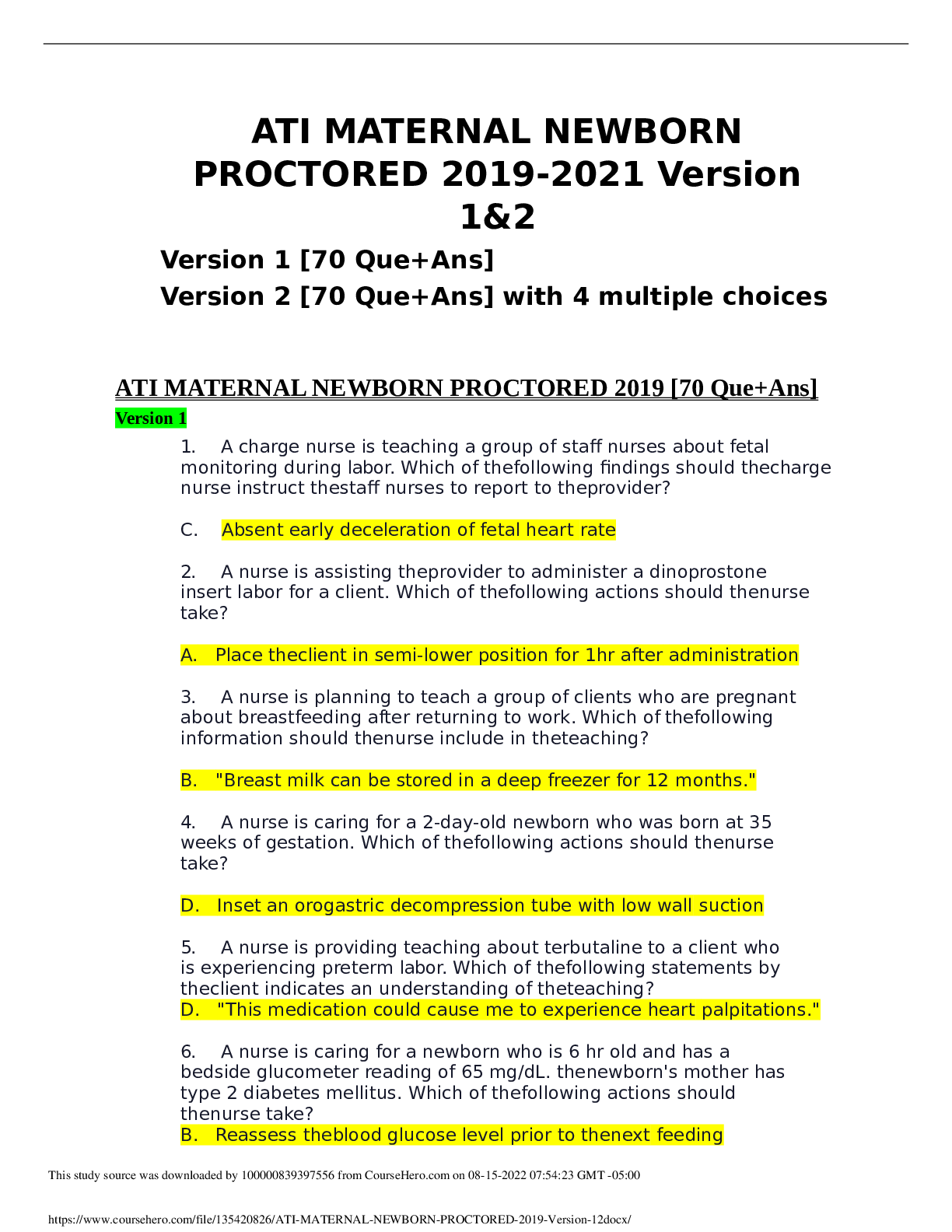ATI MATERNAL NEWBORN PROCTORED 2019
Document Content and Description Below
ATI MATERNAL NEWBORN PROCTORED 2019 A nurse is caring for a client who is 2 weeks postpartum following a cesarean birth. Which of the following clinical findings should the nurse identify as an ind... ication of postpartum infection? a. Unilateral breast pain i. Mastitis - painful or tender localized hard mass and reddened area, usually on one breast. (Pg. 143) b. Persistent abdominal striae i. Stretch marks - expected finding c. Lochia alba i. Lasts approx day 11 up to 4-8 weeks post-birth d. WBC count 12,000/mm3 2. A nurse is assessing client who has preeclampsia during a prenatal visit. Which of the following findings should the nurse report to the provider? a. Blood glucose 110 mg/dL b. Deep tendon reflexes of 2+ c. Urine protein of 3+ i. Severe preeclampsia: consists of blood pressure that is 160/110 mmHg or greater, proteinuria greater than 3+, oliguria, elevated serum creatinine greater than 1.1 mg/dL, cerebral or visual disturbances (headache and blurred vision), hyperreflexia with possible ankle clonus, pulmonary or cardiac involvement, extensive peripheral edema, hepatic dysfunction, epigastric and right upper-quadrant pain, and thrombocytopenia. (pg. 60) d. Hemoglobin 13 g/dL 3. A nurse is providing teaching about the expected effects of magnesium sulfate to a client who is at 28 weeks of gestation and has preeclampsia. Which of the following responses by the nurse is appropriate? a. “This medication improves tissue perfusion.” b. “This medication increases cardiac output.” c. “This medication stabilizes the fetal heart rate.” d. “This medication prevents seizures.” i. Depresses CNS. (Pg 61) ATI Maternal newborn 2 4. A nurse is teaching a prenatal class regarding false labor. Which of the following information should the nurse include? (pg 76) a. “You will have dilation and effacement of the cervix.” i. Sign of true labor b. “Your contractions will become temporarily regular.” . “You will have bloody show.” i. Sign of true labor d. “Your contractions will become more intense when walking.” i. Sign of true labor 5. A nurse manager is revising a maternal unit policy to ensure proper identification of newborns. Which of the following should the nurse include in the policy? a. Check the newborn’s identification using the crib card. b. Replace the infant’s identification band after his name has been recorded. c. Require visitors to wear an identification band. d. Obtain an imprint of the infant’s feet prior to taking him to the nursery. 6. A nurse is caring for a client who delivered by cesarean birth 6 hr ago. The nurse notes a steady trickle of vaginal bleeding that does not stop with fundal massage. Which of the following actions should the nurse take? a. Apply an ice pack to the incision site. b. Replace the surgical dressing. c. Administer 500 mL lactated Ringer’s IV bolus. i. This is for hydration d. Evaluate urinary output. i. Encourage the client to empty her bladder frequently (every 2 to 3 hr) to prevent possible displacement of the uterus and atony. ii. Frequent voiding of less than 150 mL of urine is indicative of urinary retention with overflow. 7. A nurse is providing discharge instructions to a client who is postpartum and has engorged breasts. Which of the following nonpharmacological comfort measures should the nurse include in the teaching? a. Wear nipple shields during the feeding. b. Use a breast binder for 2 days. c. Use plastic-lined breast pads. d. Apply cabbage leaves after feedings. 8. A nurse is calculating estimated date of birth using Naegele’s rule for a client who is pregnant and whose last menstrual cycle started June 21. Which of the following is the estimated delivery in the next year? a. March 14 b. March 21 c. March 28 i. Naegele’s rule: subtract 3 months from last menstrual period and add 7 days d. April 4 9. A nurse is caring for a client immediately following the delivery of a stillborn fetus. Which of the following actions should the nurse take? a. Inform the client that the law requires her to name the fetus. b. Limit the amount of time the fetus is in the client’s room. i. Have as much time :D c. Instruct the client that an autopsy should be performed within 24 hr. d. Prepare the client for what to expect the fetus to look like. 10. A nurse is observing an adolescent client who is offering her newborn a bottle while he is lying in the bassinet. When the nurse offers to pick the newborn up and place him in the client’s arms, the mother states, “No, the baby is too tired to be held.” Which of the following actions should the nurse take? a. Demonstrate how to hold the newborn and allow client to practice. b. Persuade the client to breastfeed the newborn to promote bonding. c. Offer to take the newborn to the nursery to finish his feeding. d. Insist that the mother pick up the newborn to feed him. 11. A nurse is caring for a client who is in labor. Which of the following findings should prompt the nurse to reassess the client? a. Intense contractions lasting 45 to 60 seconds b. An urge to have a bowel movement during contractions c. A sense of excitement and warm, flushed skin d. Progressive sacral discomfort during contractions 12. A nurse is assessing a client who is at 27 weeks of gestation and has preeclampsia. Which of the following findings should the nurse report to the provider? a. Hemoglobin 14.8 g/dL i. normal b. Urine protein concentration 200 mg/24 hr i. No protein should be detected in urine - indication of kidney damage d/t HTN. ii. Actually no. It’s a maternal adaptation to possibly have proteinuria. Now the only thing is the range.c. Creatinine 0.8 mg/dL i. normal d. Platelet count 60,000/mm3 i. LP: Low platelets (less than 100,000/mm3), resulting in thrombocytopenia, abnormal bleeding and clotting time, bleeding gums, petechiae, and possibly disseminated intravascular coagulopathy 13. A nurse in a clinic is preparing to measure the fundal height of a client who is pregnant. Which of the following actions should the nurse take? a. Lay the tape measure horizontally over the middle of the client’s abdomen. b. Place the client in a left-lateral position to obtain the measurement. c. Ensure that the client has a full bladder before taking the measurement. i. External abdominal ultrasound. d. Measure from the upper border of the pubis to the upper border of the fundus. 14. A nurse is caring for a client who is at 20 weeks of gestation and reports constipation. Which of the following recommendations should the nurse make to help retrieve this common discomfort of pregnancy? a. Include 18 g of fiber in the diet each day. i. Total fiber AI is 25 g/day for women and 38 g/day for men. (Nutrition 2016 ATI) b. Drink 2 to 3 L of water each day. . Pg. 121 increase fluids ii. Suggest that the client increase roughage and fluid intake in diet to assist with discomforts of constipation. c. Add 30 mL of mineral oil to each meal. d. Tale 60 mL of magnesium hydroxide once daily. 15. A nurse is assessing the fetal heart rate for a client who is at 38 weeks of gestation. When using an ultrasound device, the nurse hears blood rushing through the umbilical vessels in synchronization with the fetal heart beat. Which of the following terms should the nurse use to document this finding? a. Goodell’s sign i. Probable sign b. Funic souffle i. Soft, muffled, blowing sound produced by the blood rushing through the umbilical vessels and synchronous with the fetal heart sounds. (Lowdermilk) c. Quickening d. Hegar’s sign i. Probable sign ii. Softening and compressibility of the lower uterus 16. A nurse manager in a newborn nursery is reviewing infection control procedures with a group of newly hired nurses. Which of the following instructions should the nurse manager include in the teaching? a. Allow parents to enter the nursery if they are wearing a mask. i. Pg. 165 ii. Cover gowns or special uniforms are used to avoid direct contact with clothes. b. Place newborn bassinets at least 3 feet apart. i. Pg. 165 ii. Provide individual bassinets, equipped with a thermometer, diapers, T-shirts, and bathing supplies. iii. All personnel who care for newborn should scrub up with antimicrobial soap from elbows to fingertips before entering the nursery. c. Place the newborn’s foot on a sterile field during a heelstick. d. Maintain airborne precautions in the nursery. 17. A nurse is caring for a client who is receiving magnesium sulfate by continuous IV infusion. The nurse notes a respiratory rate of 8/min and absent deep-tendon reflexes. Which of the following medications should the nurse administer? a. Phytonadione i. Vitamin K reversal b. Acetylcysteine i. APAP reversal c. Protamine sulfate i. Heparin reversal d. Calcium gluconate i. Admin for magnesium toxicity ii. Signs of Mg toxicity: absence patellar deep tendon reflexes, urine output <30mL/hr, resp <12/min, decreased LOC, cardiac dysrhythmias 18. A nurse is caring for a client who is 8 hr postpartum following vaginal delivery and is unable to void. Which of the following interventions should the nurse use to promote voiding? a. Apply suprapubic pressure. b. Administer a diuretic to the client. c. Insert an indwelling urinary catheter. d. Encourage the client to void in the shower. 19. A nurse manager on the labor and delivery unit is teaching a group of newly licensed nurses about maternal cytomegalovirus. Which of the following information should the nurse manager include in the teaching? a. “Mothers will receive prophylactic treatment with acyclovir prior to delivery.” i. Because no treatment for cytomegalovirus exists, tell the client to prevent exposure by frequent hand hygiene before eating, and after handling infant diapers and toys. b. “Transmission can occur via the saliva and urine of the newborn.” i. Cytomegalovirus (member of herpes virus family) is transmitted by droplet infection from person to person, a virus found in semen, cervical and vaginal secretions, breast milk, placental tissue, urine, feces, and blood. Latent virus can be reactivated and cause disease to the fetus in utero or during passage through the birth canal. (pg. 48) ii. There is no treatment for cytomegalovirus. c. “This infection requires airborne precautions are initiated for the newborn.” i. Transmitted by droplet infection. d. “Lesions are visible on the mother’s genitalia.” i. Asymptomatic or mononucleosis-like manifestations 20. A nurse in a prenatal clinic is caring for a client who has hyperemesis gravidarum. Which of the following is the initial laboratory testused to evaluate this condition? a. Liver enzymes b. Complete blood count i. Hct concentration is elevated b/c inability to retain fluids results in hemoconcentration ii. Pg 58 c. Urine ketones i. Urinalysis for ketones and acetones (breakdown of protein and fat) is the most important initial laboratory test: Elevated urine specific gravity. ii. 1.005 to 1.030d. Thyroid levels 21. A nurse in a prenatal clinic is reviewing the laboratory results for a client who is at 12 weeks gestation. Which of the following actions should the nurse take? (Click in the “Exhibit” button for additional information about the client. There are three tabs that contain separate categories of data.) a. Administer ceftriaxone IM. i. Neisseria gonorrhoeae ii. Ceftriaxone IM and azithromycin PO: Broad-spectrum antibiotic; bactericidal action b. Administer rubella vaccine. i. 1:8 is aight. c. Obtain a maternal serum alpha-fetoprotein specimen. i. Used to rule out Down syndrome (low level) and neural tube defects (high level). 15-22 weeks gestation. d. Obtain a blood culture. 22. A nurse is teaching a client about the basal body temperature method of contraception. Which of the following statements should the nurse include in the teaching? (pg 4) a. “Your risk of pregnancy is greatest on days 21 to 28 of your cycle.” i. Fertile days are 8-19 b. “You should take your temperature before getting up for the day.” i. Measure oral temperature prior to getting out of bed each morning to monitor ovulation ii. Basal body temperature method c. “You should abstain from intercourse when your temperature is above 100 F.” d. “Your temperature may increase slightly immediately prior to ovulation.” i. Temperature may DROP slightly before ovulation 23. A nurse is providing education to a client who is to receive misoprostol for induction of labor. Which of the following instructions should the nurse include in the teaching? a. “You will lie on your side for 40 minutes after I administer the medication.” i. The client should remain in a side-lying position. b. “I will begin an oxytocin infusion within 2 hours of your last dose of medication.” c. “You will receive an antacid containing magnesium before the medication.” d. “I will insert a urinary catheter before I administer the medication.” 24. A nurse is planning care for a client in the postpartum unit. Which of the following goals should the nurse identify for the client to accomplish during the taking-in phase of postpartum adjustment? a. The client will identify individual family member roles. i. Interdependent: letting-go phase (pg. 125) 1. Focus on family as a unit 2. Resumption of role (intimate partner, individual) b. The client will have adequate nutritional intake. i. Dependent: taking-in phase 1. Focus on meeting personal needs c. The client will verbalize appropriate car seat safety. i. Dependent-independent: taking-hold phase 1. Focus on baby care and improving caregiving competency d. The client will demonstrate proper bathing of the infant. i. Dependent-independent: taking-hold 1. Focus on baby care and improving caregiving competency 25. A nurse in the antepartum clinic is teaching a client who is at 28 weeks of gestation and has preeclampsia. Which of the following instructions should the nurse include in the teaching? a. “Limit your fluid intake to four 8-ounce glasses per day.” i. Instruct the client to drink six to eight 8-ounce glasses of water a day. (pg. 61) b. “Count your baby’s movements daily.” i. Preeclampsia affects the baby; the mom may not be able to supply enough oxygen to the infant = baby not moving = indicates that the baby is not well-oxygenated. c. “Reduce your calcium intake to less than 1 gram per day.” d. “Alternate arms each time you check your blood pressure.” 26. A nurse is caring for a client who is at 37 weeks of gestation and is being tested for group B streptococcus B-hemolytic (GBS). The client ismultigravida and multipara with no history of GBS. She asks the nurse why the test was not conducted earlier in her pregnancy. Which of the following is an appropriate response by the nurse? a. “We need to know if you are positive for GBS at the time of delivery.” i. Obtain a vaginal/anal culture at 35 to 37 weeks of gestation to assess for GBS infection. Pg. 20 ii. GBS is a bacterial infection that can be passed on to the fetus during labor and delivery. Pg. 48 b. “There was no indication of GBS in your earlier prenatal testing.” i. Manifestations: premature rupture of membranes, chorioamnionitis, UTI, maternal sepsis c. “You didn’t report any symptoms of GBS during your pregnancy.” i. Patient wouldn’t know if she has symptoms during pregnancy if she wasn’t educated. ii. Patient can report HISTORY of having it. d. “Your previous deliveries were all negative for GBS.” 27. A nurse is assessing a full-term newborn upon admission to the nursery. Which of the following clinical findings should the nurse report to the provider? a. Single palmar creases i. Simian line ii. Often seen in Asian infants or in infants with Down Syndrome b. Transient circumoral cyanosis i. Short-term circumoral cyanosis c. Rust-stained urine i. Uric acid crystals will produce a rust color in the urine the first couple of days of life. d. Subconjunctival hemorrhage i. Subconjunctival hemorrhages can result from pressure during birth. 28. A nurse is caring for a client who is postpartum and experiencing hypovolemic shock. Which of the following findings should the nurseexpect? a. Respiratory rate 18/min i. Normal respiratory rate. Someone with hypovolemic shock is tachypneic b. Cool, clammy skin i. Manifestations of hypovolemic shock: tachypnea, hypotension, pallor, and cool, clammy skin. c. Urinary output 30 mL/hr d. Bounding pulses 29. A nurse is teaching a client who is at 8 weeks of gestation about self-care during pregnancy. Which of the following statements should the nurse make? a. “You can take 400 milligrams of ibuprofen for discomfort.” b. “You should take 600 micrograms of folic acid per day.” i. Majority of birth defects occur between 2 and 8 weeks of gestation. Pg. 19 ii. Women who become pregnant take 600 mcg of folic acid. Pg. 25 c. “You can take black cohosh once a day for insomnia.” i. OTC not to be taken during pregnancy d. “You should limit your daily fluid intake to 1,000 milliliters per day.” i. 8 to 10 glasses (2.3 L) of fluid are recommended daily 30. A nurse is planning care for a client who is receiving oxytocin by continuous IV infusion for labor induction. Which of the following interventions should the nurse include in the plan? a. Increase the infusion rate every 30 to 60 min. i. Increase oxytocin as prescribed until desired contraction pattern is obtained. Pg. 101 ii. Keep the IV line open and increase the rate of IV fluid to 200 mL/hr unless contraindicated. Pg. 101b. Maintain the client in a supine position. i. Position client side-lying position to increase uteroplacental perfusion. Pg. 101 c. Limit IV intake to 4 L per 24 hr. d. Titrate the infusion rate by 4 milliunits/min. 31. A nurse is providing teaching about expected changes during pregnancy to a client who is at 24 weeks of gestation. Which of the following information should the nurse include? a. “You should expect your uterus to double in size.” b. “Your stomach will empty rapidly.” i. Slowed stomach emptying. c. “Your nipples will become lighter in color.” i. Darkened areolae (pg. 15) d. “You should anticipate nasal stuffiness.” i. A common discomfort of pregnancy. (pg. 22) 32. A nurse is assisting the provider to administer a dinoprostone insert to induce labor for a client. Which of the following actions should the nurse take? a. Verify that the informed consent is obtained prior to administration. i. Obtain the client’s informed consent form. (pg. 100) b. Allow the medication to reach room temperature prior to administration. c. Instruct the client to avoid urinary elimination until after administration. i. Assist the client to void prior to the procedure. d. Place the client in a semi-Fowler’s position for 1 hr after administration. i. The client should remain in a side-lying position. 33. A nurse is preparing to administer metronidazole 2 g PO to a client who has pelvic inflammatory disease. Available is metronidazole 500mg tablets. How many tablets should the nurse administer? (Round the answer to the nearest whole number. Use a leading zero if it applies. Do not use a trailing zero.) a. 2g → 2000 mg b. 2000mg / 500 mg = 4 tablets 34. A nurse in a prenatal clinic is caring for a group of clients. Which of the following clients should the nurse recommend for an interdisciplinary care conference? a. A client who is at 37 weeks of gestation and has an L/S ratio 2:1 i. LECITHIN/SPHINGOMYELIN (L/S) RATIO (pg. 34) ii. A 2:1 ratio indicates fetal lung maturity iii. 2.5:1 or 3:1 for a client who has diabetes mellitus b. A client who is at 35 weeks of gestation and has a biophysical profile of 6 i. 8 TO 10: normal, low risk of chronic fetal asphyxia (pg. 30) ii. 4 TO 6: abnormal, suspect chronic fetal asphyxia iii. LESS THAN 4: abnormal, strongly suspect chronic fetal asphyxia c. A client who is at 39 weeks of gestation and has a negative contraction stress test i. NEGATIVE CST (Normal finding): Indicated if within a 10-min period, with three uterine contractions, there are no late decelerations of the FHR d. A client who is at 28 weeks of gestation and has a negative Coombs titer 35. A nurse is planning to teach a group of clients who are pregnant about breastfeeding after returning to work. Which of the following information should the nurse include in the teaching? a. “Thawed breast milk that is unused can be refrozen.” i. Do not refreeze thawed milk. b. “Breast milk can be stored at room temperature for up to 12 hours.” i. Breast milk can be stored at room temperature under very clean conditions for up to 8 hr c. “Breast milk can be stored in a deep freezer for 12 months.” i. Breast milk can be stored in a deep freezer for 12 months. (pg. 171) d. “Thawed breast milk can be refrigerated for up to 72 hours.” i. Thawing the milk in the refrigerator for 24 hr is the best way to preserve the immunoglobulins present in it. 36. A nurse is performing an initial assessment of a newborn who was delivered with a nuchal cord. Which of the following clinical findings should the nurse expect? a. Erythema toxicum i. A pink rash that appears suddenly anywhere on the body of a term newborn during the first 3 weeks. b. Periauricular papillomas c. Telangiectatic nevi i. Stork bites. Flat pink or red marks that easily blanch and are found on the back of the neck, nose, upper eyelids, and middle of the forehead. They usually fade by the second year of life. d. Facial petechiae i. Bruises or petechiae may be present on the head, neck, and face of an infant born with a nuchal cord (cord around the neck). (Lowdermilk) ii. Expected Findings: Localized discoloration, ecchymosis, petechiae, and edema over the presenting part are seen with soft-tissue injuries. (ATI) 37. A nurse is assessing a newborn upon admission to the nursery. Which of the following findings should the nurse expect? a. Length from head to heel of 40 cm (15.7 in) i. 45 to 55 cm (18 to 22 in) b. Bulging fontanels i. Bulging fontanels can indicate increase intracranial pressure, infection, or hemorrhage c. Chest circumference 2 cm (0.8) smaller than the head circumference i. Chest - 30 to 33 cm, Head - 32 to 36.8 cm d. Nasal flaring i. Respiratory distress: nasal flaring, grunting, retractions, gasping, and labored breathing. (pg. 164) 38. A nurse is assisting with a precipitous delivery of a term newborn. After the head emerges, the nurse palpates the cord around the newborn’s neck. Which of the following actions should the nurse take? a. Apply fundal pressure. b. Place the client in the knee-chest position. i. Reposition to relieve pressure on the cord (pg. 107) c. Apply a water-based lubricant to the cord. d. Slip the cord over the newborn’s head. 39. A nurse is planning care for a newborn who is to undergo a circumcision using a plastic bell device. Which of the following interventions should the nurse include in the plan of care? a. Wash the circumcision site with mild soap and water 24 hr following the procedure. i. Change the newborn’s diaper at least every 4 hr, and clean the penis with warm water with each diaper change (p. 178) b. Take off the plastic bell 2 hr after the procedure. i. Plastibell drops off after 5 to 7 days c. Monitor for bleeding every 15 min for the first hour. i. Assess for bleeding every 15 to 30 min for the first hour and then hourly for the next 4 to 6 hours (pg. 178) d. Remove the yellow drainage on the second postoperative day. i. Film of yellowish mucus can form over the glans by day two, and it is IMPORTANT not to wash if off. 40. A nurse is providing discharge instructions to a client who is 24 hr postpartum and has decided not to breastfeed. Which of the following instructions should the nurse include in the teaching? a. “Shower daily, allowing warm water to run directly over your breasts.” b. “Apply ice packs to your breasts using a 15 minutes on, 45 minutes off schedule.” c. “Wear a loose-fitting, nonbinding bra for 72 hours.” i. Wear a well-fitting bra for support. d. “Pump your breasts twice daily to relieve discomfort from engorgement.” 41. A nurse is preparing to administer methylergonovine 0.2 mg orally to a client who is 2 hr postpartum and has a boggy uterus. For which of the following assessment findings should the nurse withhold the medication? a. Respiratory rate 14/min b. Blood pressure 142/92 mm Hg c. Urine output 100 mL in 3 hr d. Pulse 58/min 42. A nurse is caring for four newborns. Which of the following findings should the nurse report to the provider? a. A newborn who has molding with overlapping suture lines b. A female newborn who has blood-tinged vaginal discharge i. Vaginal blood-tinged discharge can occur in female newborns, which is caused by maternal pregnancy hormones. This is an expected finding. (p. 159) c. A newborn who has a high-pitched cry with exaggerated Moro reflex i. CNS: High-pitched, shrill cry, incessant crying, irritability, tremors, hyperactivity with an increased Moro reflex, increased deep-tendon reflexes increased muscle tone, disturbed sleep pattern, hypertonicity, convulsions (p. 183) ii. Neonatal substance withdrawal d. A male newborn who has a scrotal edema i. Hydrocele, normal. 43. A nurse in a provider’s office is caring for a 20-year-old client who is at 12 weeks of gestation and requests an amniocentesis to determine the gender of the fetus. Which of the following responses should the nurse take? a. “We can schedule the procedure for later today if you’d like.” i. It’s performed after 14 weeks of gestation b. “You cannot have an amniocentesis until you are at least 35 years of age.” c. “This procedure determines if your baby has genetic or congenital disorders.” d. “Your provider will schedule a chorionic villus sampling to determine the sex of your baby.” i. CVS is an earlier diagnosis of any abnormalities including Down syndrome and neural tube defects 44. A nurse is caring for a client who is postpartum. The client reports no relief in perineal pain following the administration of oxycodone/acetaminophen. Which of the following actions should the nurse take first? a. Reposition the client. i. Need to verify possible cause of pain first? b. Apply an ice pack to the client’s perineum. c. Assess the client’s perineal area for swelling. d. Administer ibuprofen to the client. 45. A nurse is caring for a client who is in active labor and has gonorrhea. For which of the following potential complications of gonorrhea should the nurse monitor? a. Chorioamnionitis b. Vaginal laceration during birth c. Excessive bleeding after birth d. Oligohydramnios 46. A nurse is caring for a client who is in labor. The nurse observes late decelerations of the fetal heart rate on the external fetal monitor. After placing the client in a side-lying position, which of the following actions should the nurse take? a. Decrease the rate of IV fluids. i. Increase the rate of IV fluid administration b. Elevate the client’s head. i. Elevate the client’s leg c. Administer oxygen via a face mask. i. Administer o2 by mask at 8 to 10 L/min via nonrebreather face mask d. Perform fetal scalp stimulation. 47. A nurse is caring for a newborn who has exstrophy of the bladder. Which of the following actions should the nurse take prior to the beginning of surgical correction? a. Keep the newborn in a side-lying position. b. Restrict the newborn’s fluid intake. c. Cover the newborn’s bladder with a sterile, non-adherent dressing. d. Exert gentle pressure on the newborn’s bladder with sterile gauze. 48. A nurse is reviewing the laboratory report of a client who is 24 hr postpartum vaginal delivery. The client has a hemoglobin level of 9.0 g/dL and hematocrit of 25%. Which of the following actions should the nurse take? a. Initiate IV access for isotonic solution with an 18-gauge catheter. b. Prepare the client for a blood transfusion. c. Administer an iron supplement to the client. d. Instruct the client that the provider will check for placental fragments. 49. A nurse is caring for a client who is receiving magnesium sulfate by continuous IV infusion for severe preeclampsia. Which of the following findings should the nurse report to the provider? a. Deep tendon reflex 2+ b. Absence of clonus c. Facial flushing d. Urine output 20 mL/hr 50. A nurse is performing a heel stick on a newborn. Which of the following actions should the nurse take? a. Place an ice pack on the newborn’s heel 5 min before the procedure. b. Cleanse the newborn’s heel with an alcohol swab after the procedure. c. Use an automatic puncture device on the heel. d. Puncture the heel in the inner aspect of the foot. 51. A nurse is caring for a client who has bladder distention following a vaginal birth. Which of the following actions should the nurse take first? a. Assist the client to the bathroom. b. Offer the client a sitz bath. c. Insert a urinary catheter. d. Pour warm water over the client’s perineum. 52. A nurse is providing teaching about increasing dietary fiber to an antepartum client who reports constipation. Which of the following food selections has the highest fiber content per cup? a. Lentils b. Oatmeal c. Cabbage d. Asparagus 53. A nurse is caring for a client following an amniocentesis. The nurse should observe the client for which of the following complications? a. Proteinuria b. Hyperemesis c. Hypoxia d. Hemorrhage 54. A nurse is in a clinic caring for a client who is in her second trimester pregnancy. The client expresses concern about preparing her 2-yearold- child for a new sibling. Which of the following is an appropriate response by the nurse? a. “Move your toddler to his new bed 2 months before the baby comes home.” b. “Let the toddler see you carrying the baby into the home for the first time.” c. “Avoid bringing your toddler to prenatal visits.” d. “Required scheduled interactions between toddler and the baby.” 55. A nurse is assessing current medication use with a client who is at 6 weeks of gestation. The nurse should recognize that pregnancy is a contraindication the administration of which of the following medications? a. Azithromycin b. Metformin c. Diphenhyamine d. Isotretinoin 56. A nurse is assessing a client who is at 39 weeks of gestation and determines that the fetus is in a left occipitoanterior position. On which of the following sites should the nurse place the external fetal monitor to hear the point of maximum impulse of the fetal heart rate? a. Bottom right square?? Yah…. YUUUHHH!!! b. LLQ 57. A nurse is reviewing the immunization status of a client who is pregnant. The nurse should inform the client that it is safe for her to receive which of the following immunizations during pregnancy? a. Varicella b. Rubella c. Tetanus d. Rubeola 58. A nurse is reviewing laboratory findings a client who is at 20 weeks of gestation. Which of the following findings should the nurse report to the provider? a. Creatinine 0.9 mg/dL b. WBC count 11,000/mm3 c. Fasting blood glucose 180 mg/dL d. Hematocrit 35% 59. A nurse is caring for a client who is at 35 weeks of gestation and is on bed rest due to preeclampsia. Which of the following is an important action for the nurse to take? a. Maintain NPO status b. Obtain BP every 8 hours c. Keep the lights dimmed in the room. d. Auscultate fetal heart tones twice per day 60. A nurse is caring for a client who is 2 days postpartum and states “I want to continue breastfeeding, but my nipples are sore.” Which of the following responses should the nurse make? a. “Removing breast shields from your bra ll decreased discomfort.” b. “You should switch your infant to formula until the soreness goes away.” c. “Allow expressed milk to air dry on the nipples after feeding your infant.” d. “Apply an antibiotic ointment to the nipples prior to each feeding.” 61. A nurse is caring for a newborn immediately following birth notes a large amount of mucus in the newborn’s mouth and nose. Identify the sequence the nurse should follow when performing suction with a bulb syringe. a. Lace the bulb syringe in the newborn’s mouth (2) b. Compress the bulb syringe (1) c. Assess the newborn for reflex bradycardia (4) d. Set the bulb syringe suction the newborn’s nose (3) 62. A nurse is receiving report on four postpartum clients. Which of the following clients should the nurse plan to attend to first? a. A client who reports abdominal pain during breastfeeding b. A client who reports changing her perineal pad every 2 hours c. A client who has urine output of 250 mL in 6 hr i. Normal urine output is 30 mL/hr ii. 6 hr= 180mL d. A client who as hyporeflexia while receiving IV magnesium sulfate 63. A nurse is teaching a client about using a diaphragm. Which of the following instructions should the nurse include in the teaching? a. “Insert the diaphragm up to 12 hours before intercourse.” i. Insert up to 6 hr before intercourse (pg 5) b. “Remove the diaphragm 2 hours after intercourse.” i. Must stay in place 6 hr after intercourse but for no more than 24 hrs (pg 5) c. “Replace the diaphragm every 2 years.” d. “Use 2 teaspoons baby oil to lubricate the diaphragm before insertion.” i. Use spermicidal cream/jelly (pg 5) 64. A nurse is admitting a client to the birthing unit who reports her contractions started 1 hour ago. The nurse determines client is 80% effaced and 8 cm dilated. The nurse realizes that the client is at risk for which of the following conditions? a. Hyperemesis gravidarum b. Postpartum hemorrhage c. Incompetent cervix d. Ectopic pregnancy 65. A nurse is providing vehicle safety education to parents of a premature newborn. Which of the following statements should the nurse include in the teaching? a. “You should secure your newborn’s car seat at a 60 degree angle.” i. 45 degree angle to prevent slumping (ATI peds 2016 prac) b. “Your newborn will need to have a car seat test prior to discharge.” c. “Place your newborn in a front-facing car seat in the back seat of the vehicle.” i. Rear-facing car seat in back seat, preferably in the middle (pg 179) d. “Position the retainer clip at the level of your newborn’s abdomen.” 66. A nurse is providing discharge instructions to a client who is breastfeeding her newborn. Which of the following instructions should the nurse include? a. Allow the baby to feed at least every 3 hours b. Offer the newborn 30 mL (1 oz) of water between feedings c. Expect two to four wet diapers every 24 hrs d. Feed the newborn 5 to 10 min each breast 67. A nurse is assessing a client who is 2 days postpartum. Which of the following findings indicates a complication? a. Hypotonic uterus b. Hct 36% c. Platelet count 370,000/mm3 d. Perineal edema 68. A nurse is reviewing the medical record of a client who had vaginal delivery 3 hr ago. Which of the following findings place the client at risk for postpartum hemorrhage? (SATA) a. History of human papillomavirus b. Vacuum-assisted delivery c. Labor induction with oxytocin (pg 135) i. Errr it says on ATI: Prolonged labor, oxytocin induced labor. d. Newborn weight 2.948 kg (6 lb 8 oz) e. History of uterine atony (pg. 135) 69. A nurse is assessing a full-term newborn. Which of the following findings should the nurse report to the provider? a. Temperature 36.5 degrees C (97.7 degrees F) b. Blood pressure 80/50 mm Hg c. Respiratory rate 55/min d. Heart rate 72/min 70. A nurse is assessing a client who has preeclampsia and is receiving magnesium sulfate via continuous IV infusion. Which of the following findings should the nurse report to the provider? (SATA) a. Respiratory rate 11/min i. Report if respirations <12/min ii. Pg 61 b. Urine output 130 mL /4 hr i. Report if urine output < 30 mL/hr ii. Pg 61 c. Deep tendon reflexes absent i. Sign of magnesium toxicity ii. Pg 61 d. Fetal heart rate 20/min(typo its 120) e. Flushing of face [Show More]
Last updated: 1 year ago
Preview 1 out of 33 pages
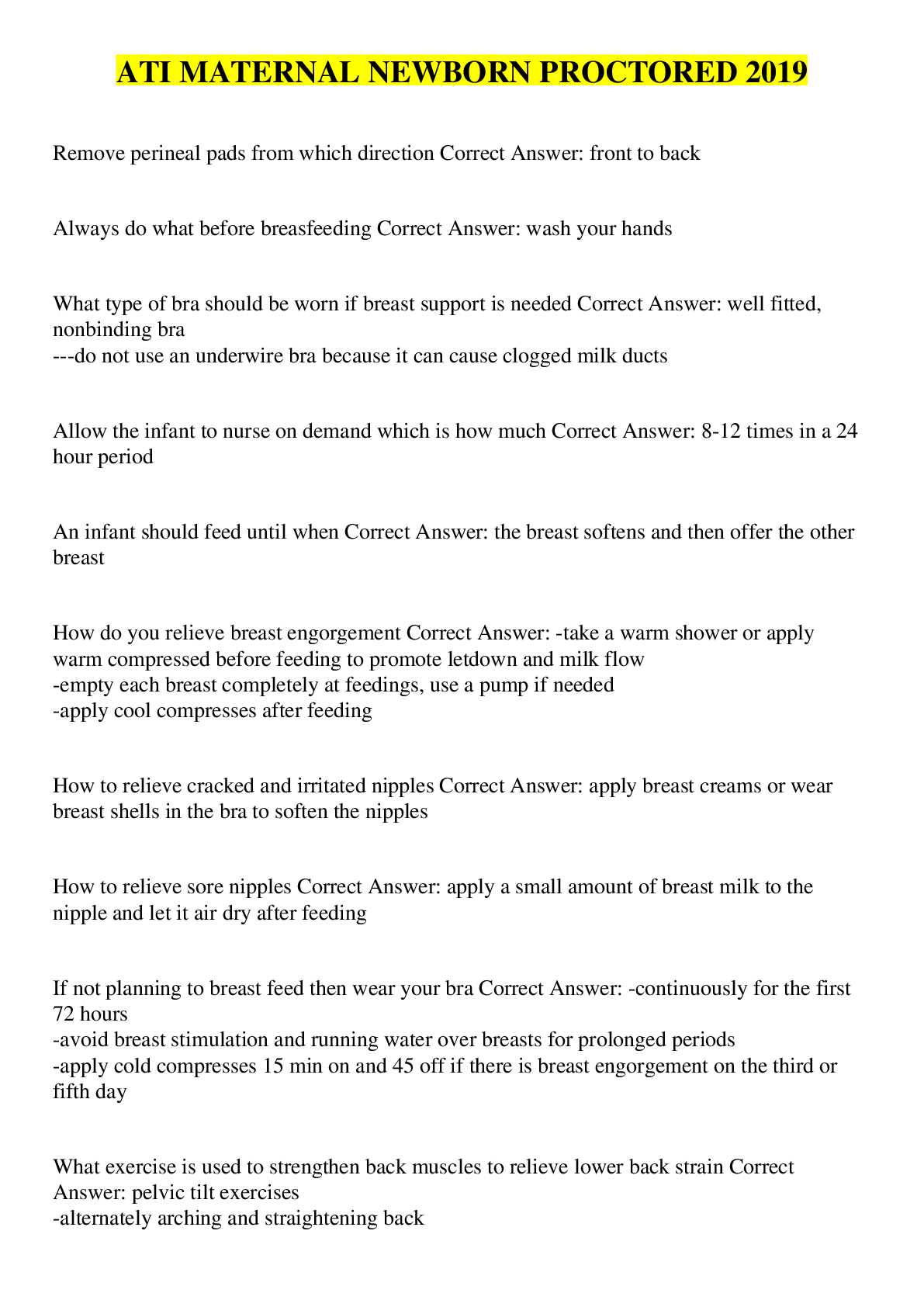
Reviews( 0 )
Document information
Connected school, study & course
About the document
Uploaded On
Jun 03, 2021
Number of pages
33
Written in
Additional information
This document has been written for:
Uploaded
Jun 03, 2021
Downloads
0
Views
114

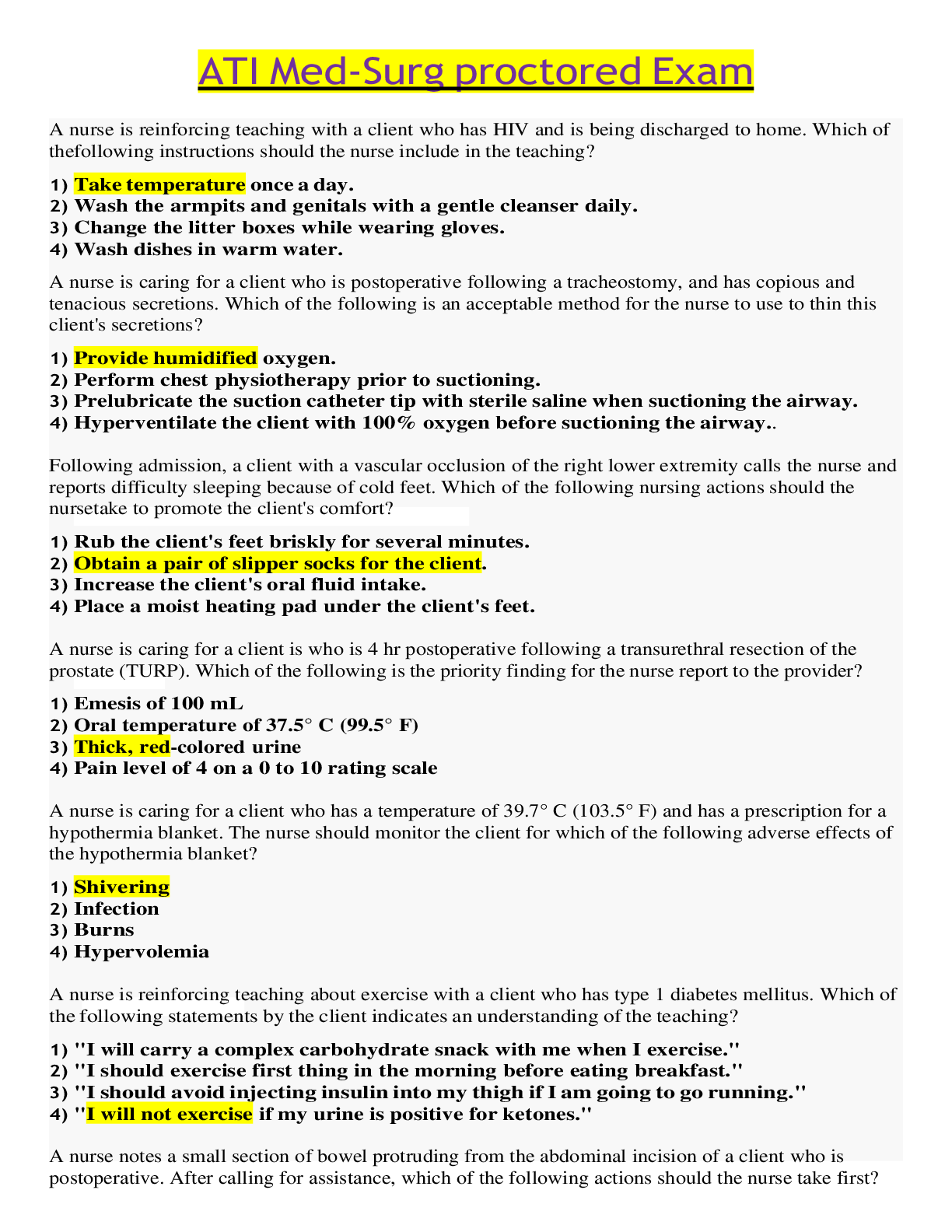
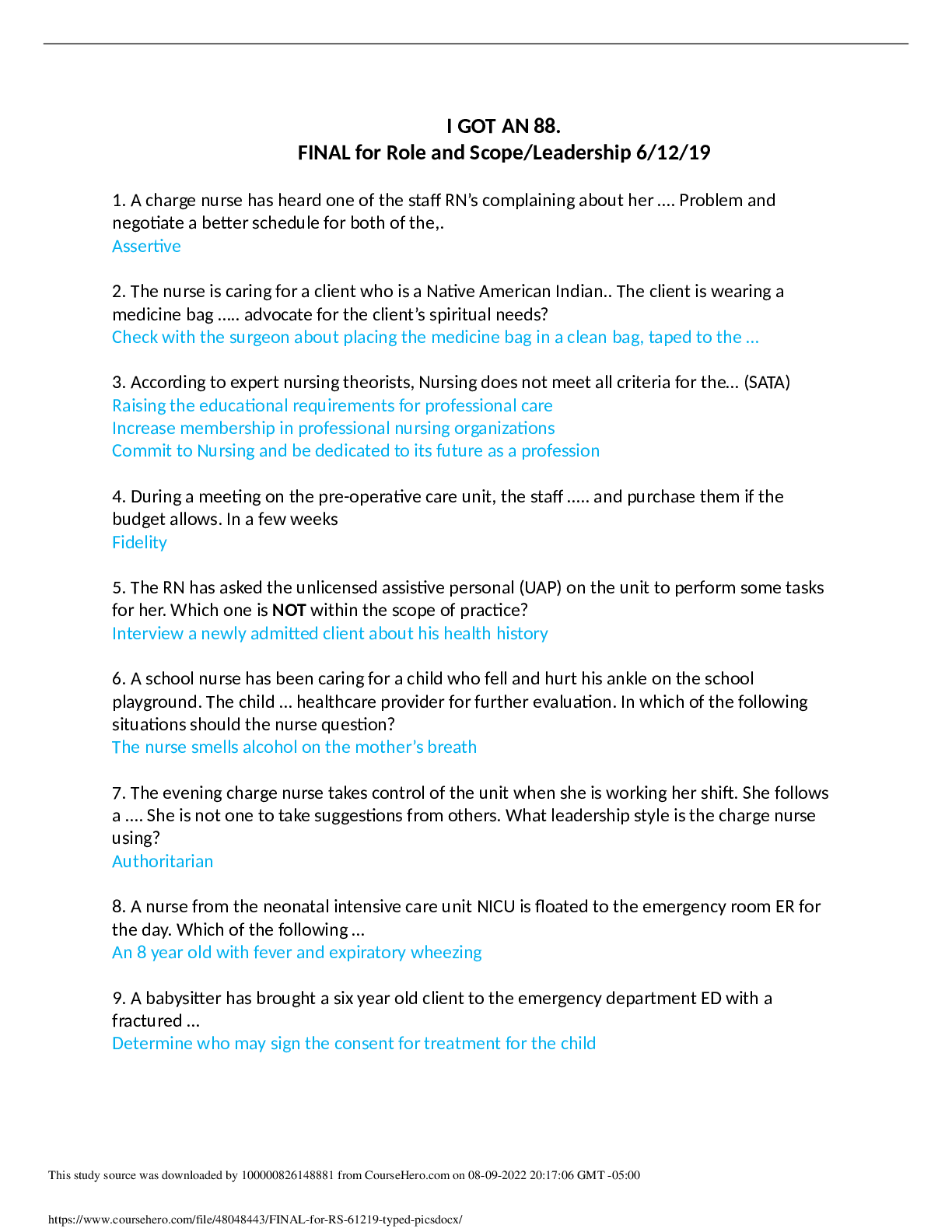
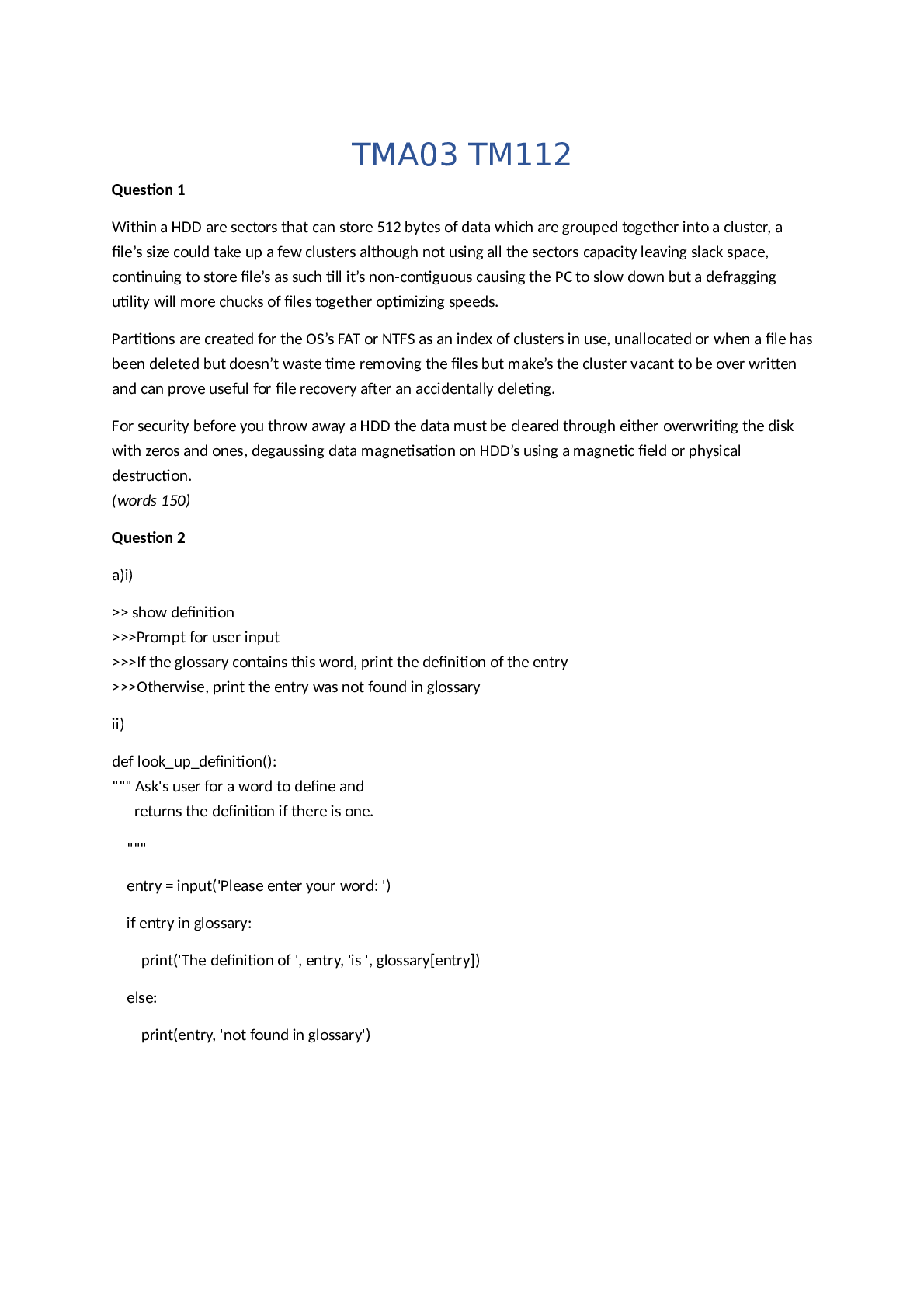
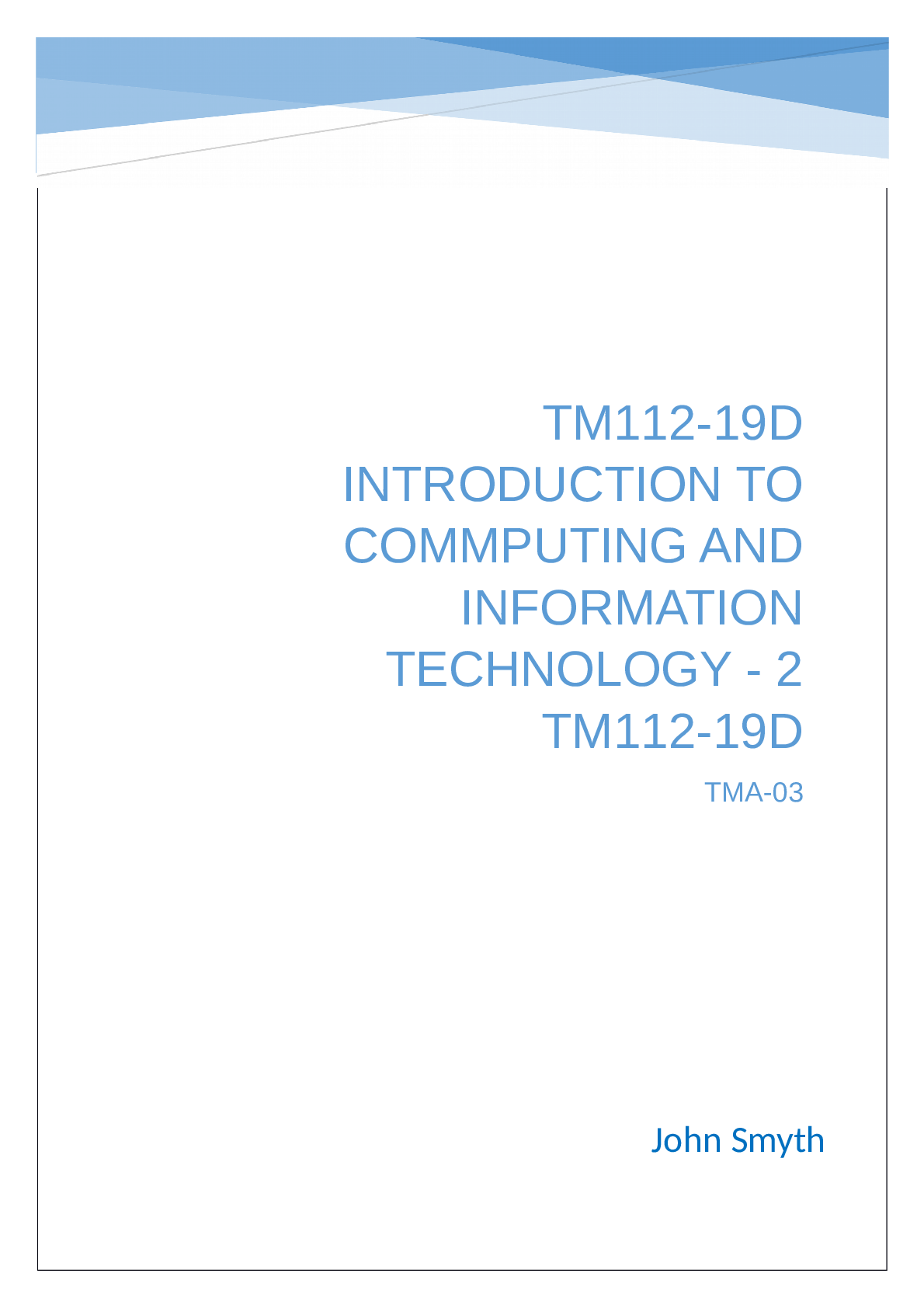
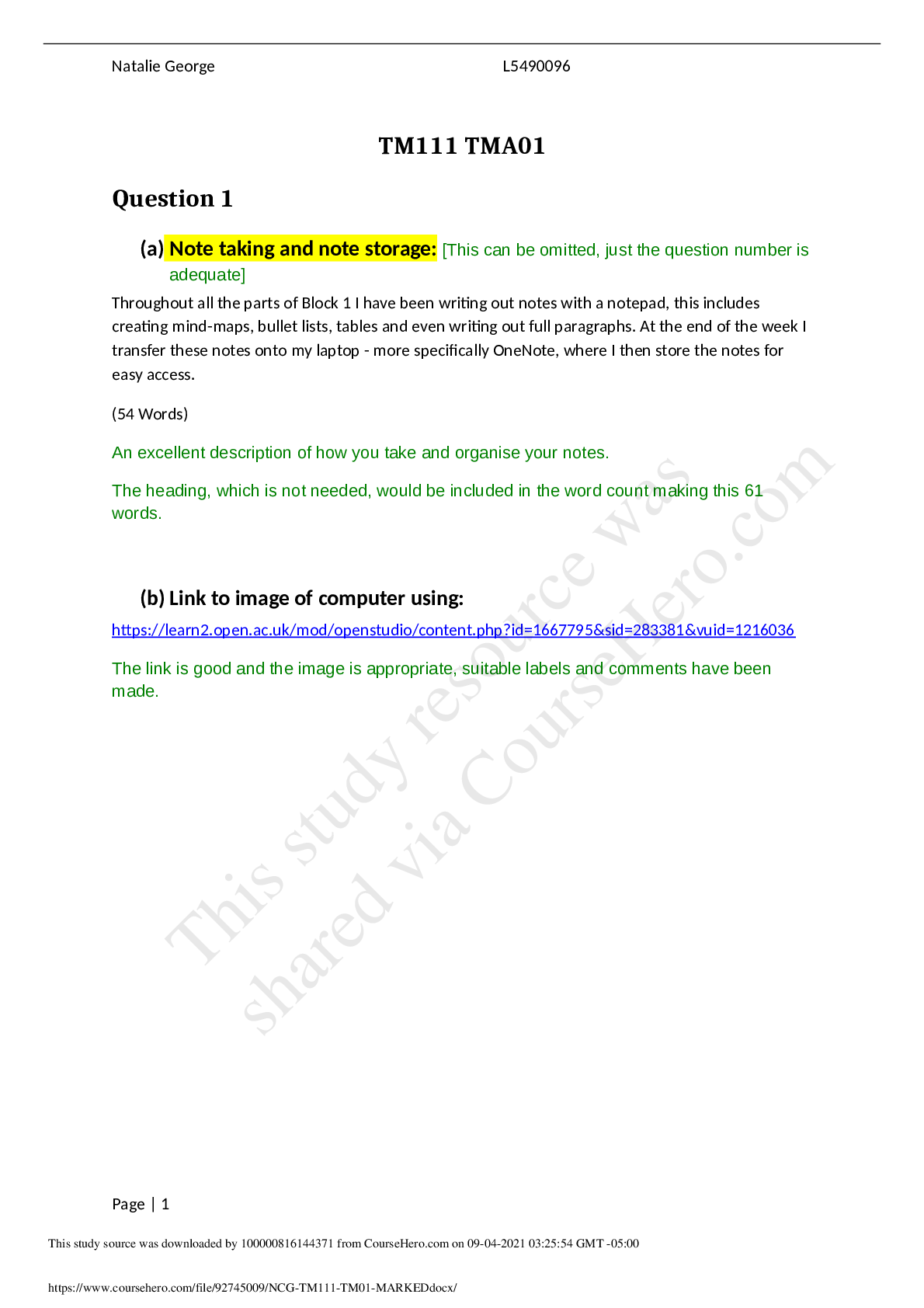
.png)
